 “In a hole in the ground there lived a hobbit.”
“In a hole in the ground there lived a hobbit.”
Reading J.R.R. Tolkien didn’t teach me a love of reading. Even at the age of 5, I already had that. But, in the summer of 1980, after I had made it through the Chronicles of Narnia, my brothers decided to hand me The Hobbit and then The Lord of the Rings and see what would happen. What happened, of course, is 33 consecutive years of reading both (sometimes more than once a year).
For a long time, this was a love that I had, but it wasn’t necessarily an overwhelming passion. I had The Lord of the Rings, The Hobbit, The Silmarillion and a few reference books (The Complete Guide to Middle-earth and The Atlas of Middle-earth). And I knew a lot about Middle-earth. But it could all easily fit in a shelf. Now it can’t even fit in a single bookcase.
“This tale grew in the telling . . .”
What happened? Well, a passion for collecting that began to focus happened. And the films happened, at a time when I was working at the world’s largest bookstore. There was suddenly a lot of Tolkien books (and Tolkien related books) around and suddenly I had more money than I had before for this kind of collecting. So, this took off, slower than Faulkner, but at a good pace.
And what has happened in the years since I left Powell’s? It has only continued to grow. In fact, I now own more copies of Lord of the Rings than I own of The Sound and the Fury. And it continues to grow because they continue to release new editions of the books and I just can’t resist.
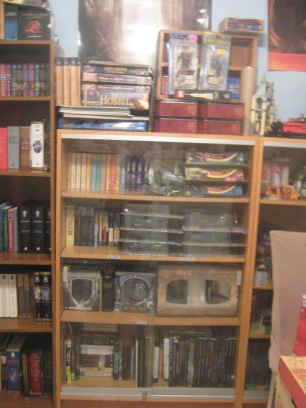 This is not a complete guide to every edition of every Tolkien book. Hell, there are some books that aren’t here at all (for some reason I don’t own any copies of Tales from the Perilous Realm). A good guide can be found here (and I took some of their information), but it’s all only a start. What this is, is a guide to my Tolkien collection, which has grown through the years because I love his work, I love to collect and I love books.
This is not a complete guide to every edition of every Tolkien book. Hell, there are some books that aren’t here at all (for some reason I don’t own any copies of Tales from the Perilous Realm). A good guide can be found here (and I took some of their information), but it’s all only a start. What this is, is a guide to my Tolkien collection, which has grown through the years because I love his work, I love to collect and I love books.
You may notice a few things here. There are almost none of the new books concerning The Hobbit: An Unexpected Journey or the new editions of the book. That’s only because we have to prioritize and I can’t afford them yet. You might also see a lot of toys and such in the pictures that aren’t on the list. The list covers books (and calendars and journals, but since those get sold in bookstores, I felt fine including them). And my collection is far from complete – I certainly don’t have 1st Editions of Lord of the Rings or The Hobbit (I am not independently wealthy) and there are other books I would like to get (like 1st Editions of The Annotated Hobbit or The Atlas of Middle-earth). I still have a want list. But, I think I have a damn impressive collection and certainly one that can match up to most people out there (that aren’t independently wealthy). But here is my collection. But three quick notes first:
- A guide to all the information in the parenthesis after each books, not to mention all of my abbreviations can be found at the end of this post.
- Most of the pictures aren’t of my specific copies, but rather pictures I grabbed off the net of the edition I have. For some of the sets, I couldn’t find a picture, so we took one (you can tell – they have the black background). Also, obviously, the pictures of the collection are mine.
- Where things are readily available (or might become so), there are links to find them for purchase. Because many of these books are out of print, they come and go, but you can make a wish list and be notified when out of print books come in. But you should be careful of any Ballantine book from the late 80’s on. They have continued to re-use the same ISBNs for many of the Tolkien books, so you might not get the cover you are looking for.
The Hobbit:
This is the book that started it all, of course, back in 1937 with the classic first line that pulls you down into a wonderful world of fantasy. Though some people grow away from The Hobbit as they age, I continue to love it and I re-read it every year before diving back into LOTR. Any copies of The Hobbit that come in LOTR sets or that match LOTR sets are listed down below.
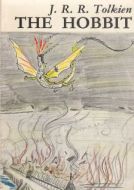 U.K. paperback (1972, Unwin Books, mm, 0048230707, 278 p)
U.K. paperback (1972, Unwin Books, mm, 0048230707, 278 p)
- This is the 3rd Edition, originally published in 1966, but this is the 13th impression, printed in 1972. It is catalog #65 in the Unwin list, which is printed in the front cover, and is amusing, because almost everything else on it is philosophy or literary criticism. The cover is the Tolkien illustration of the death of Smaug and it even goes around the book, to include Tolkien’s note about the drawing. It’s an odd choice since it was just a draft and not a finished drawing and it makes the cover look a bit unprofessional.
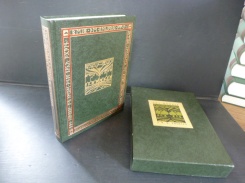 leather slipcase edition (1973, Houghton Mifflin Company, lt/sc, 0395177111, 317 p)
leather slipcase edition (1973, Houghton Mifflin Company, lt/sc, 0395177111, 317 p)
- This is a very nice looking edition, bound in green leather within a green slipcase, which is unfortunately sized just slightly off the somewhat matching LOTR (this is a bit longer but shorter). It has a gilded cover based on the original dust jacket illustration by Tolkien and includes all the standard Tolkien illustrations, including having some in color. I actually keep my copy (along with the LOTR) in a slipcase for the 3 volume Alan Lee illustrated LOTR (0618260587), because for some reason I have the slipcase but not the books themselves.
 The Hobbit 24 Page Read-Along Book and Record (1977, Disneyland / Vista Records)
The Hobbit 24 Page Read-Along Book and Record (1977, Disneyland / Vista Records)
- This was a great thing, growing up – the idea of the book and record, where you could read the book and the record would play along and chimes would tell you when to turn the page. Disney used to do this for a lot of their films, and they also branched out, covering both the Rankin / Bass Tolkien films and covering the Star Wars films (I also have the ones for the original Star Wars trilogy). As I mentioned in my review of Return of the King, having the books for those and ROTK (see below) was part of why those images stuck with me for so long growing up, even when I couldn’t watch the Rankin / Bass films themselves. One odd thing about this one – while all the pages inside have still from the movie, the cover itself is not – it is modeled on that style of animation, but Bilbo is far too wrinkly and looks kind of odd (this same drawing of Bilbo is used on the frontispiece of the edition illustrated from this film). The narrator is unknown, but he does a good job of mimicking all the voices from the film.
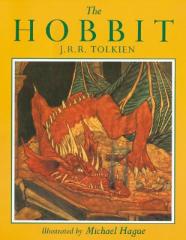 1984 illustrated version (illustrated by Michael Hague, Houghton Mifflin Company, tp, 0395520215, 290 p)
1984 illustrated version (illustrated by Michael Hague, Houghton Mifflin Company, tp, 0395520215, 290 p)
- This is a nice large size trade edition with 48 full color illustrations. The good news is that I really like the Smaug illustration on the front cover. The bad news is that I don’t think very much of most of the rest of the illustrations – the cover picture is definitely the high point. The biggest problem to me is that Bilbo seems to be drawn as if he’s a child (I wonder if the model was a child and Hague just couldn’t get away from that in the face).
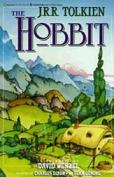 1991 graphic novel (illustrated by David Wenzel, adapted by Charles Dixon with Sean Deming, Ballantine, tp, 0345368584, 133 p)
1991 graphic novel (illustrated by David Wenzel, adapted by Charles Dixon with Sean Deming, Ballantine, tp, 0345368584, 133 p)
- This graphic novel version of The Hobbit appeared in 1991 and I bought it for my brothers for Christmas. Yes, I didn’t buy it until some 20 years later. Why? Well, because my passion for collecting back then was aimed at baseball cards and comic books and my book collection hadn’t gone bonkers yet. And because I don’t particularly like it. Not just the art, which I don’t like (especially Bilbo, who looks too much like the Bakshi version). It’s that the three people working together – the adapters and the illustrator decided to try and cram in as much of the story as possible. To their credit, every word comes straight from the book. Not to their credit is that every panel seems crammed, either with narrative or exposition. It’s all just way too busy.
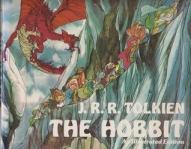 1993 illustrated edition (illustrated with images from the Rankin / Bass film, Galahad Books, hc, 0883657465, 220 p)
1993 illustrated edition (illustrated with images from the Rankin / Bass film, Galahad Books, hc, 0883657465, 220 p)
- This is a 1993 hardcover reprint of what was originally a paperback illustrated edition published in 1977. That edition (which my brother had and which I was rarely allowed to look at because the pages were falling out) was a copy to accompany the Rankin / Bass television film and is filled with illustrations from the film (while some are still, other appear to be storyboards or other supplemental art). I have always loved this because these were the images that I grew up with, having seen the film as a kid and looking at this book on occasion and having the book and record.
 Tolkien Collection (1999, HarperCollins Publishers, mm, 0261102214, 310 p)
Tolkien Collection (1999, HarperCollins Publishers, mm, 0261102214, 310 p)
- For the Tolkien Collection, HarperCollins reprinted The Hobbit, all three volumes of LOTR, The Silmarillion, Unfinished Tales, Roverandom and Tales from the Perilous Realm with matching black covers and Tolkien artwork on the covers. This is a 16th printing of that 1999 edition. It contains the Tolkien artwork. It is longer than most editions because it also contains the first chapter of Fellowship.
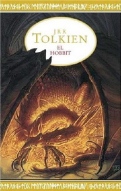 El Hobbit (2001, Minotauro, tp, 9505470630, 309 p)
El Hobbit (2001, Minotauro, tp, 9505470630, 309 p)
- The Spanish language edition. Though the first Minotauro edition was printed in 1991, this is the 2001 edition that was getting a large reprint to go along with the movie edition Spanish language covers for LOTR. The cover art is by John Howe. An interesting thing to note (and the same is true for the other Spanish editions below) – the Contents page, normally found at the beginning of the book, is, in fact, the very last page in the book. An odd choice on the map of Thror here – while the original versions of the map in English use a flowing script that seems like it could be the work of a real scribe, the maps here clearly use the Zapf Chancery font. The translation is by Manuel Figueroa.
 2001 young readers edition (Houghton Mifflin Company, tp, 061815082x, 330 p)
2001 young readers edition (Houghton Mifflin Company, tp, 061815082x, 330 p)
- This is one of a couple of editions that HM list as a young readers edition. This, which runs 35 fewer pages then the next young readers edition has illustrations by Tolkien. However, it has cover art from Peter Sís. It is a nice reading copy, but I find it so bizarre that it has the Tolkien illustrations that the other one doesn’t when the other edition uses a Tolkien cover and this doesn’t.
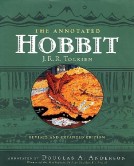 The Annotated Hobbit: Revised and Expanded Edition (annotated by Douglas A. Anderson, 2002, Houghton Mifflin Company, hc, 0618134700, 398 p)
The Annotated Hobbit: Revised and Expanded Edition (annotated by Douglas A. Anderson, 2002, Houghton Mifflin Company, hc, 0618134700, 398 p)
- The single best copy of The Hobbit to have. First of all, it has meticulously researched annotations and they really expand not only our notions of how Tolkien wrote the book, but also its place in fantasy history. Then there are the illustrations – Anderson not only includes a heavy dose of Tolkien’s own illustrations (one of which is on the cover), but also a wide array of foreign illustrators through the years (some of which are quite awful, which Anderson fully admits, and he also mentions Tolkien’s feelings about some of them). It is a magnificent book, very well designed, with two appendices and a bibliography and the cover is simply wonderful. The original edition, which essentially used the original Hobbit dust jacket was published in 1988.
 2002 young readers edition (Houghton Mifflin Company, tp, 0618260307, 365 p)
2002 young readers edition (Houghton Mifflin Company, tp, 0618260307, 365 p)
- Houghton themselves list this as the young readers edition. Though, it is interesting that they would designate it as the young readers edition without any illustrations in it. It does have a cover by Tolkien, his illustration of Bilbo speaking to Smaug (which is odd since the other young readers edition has the Tolkien illustrations in the book but not a Tolkien cover).
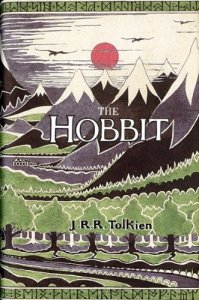 The Hobbit included with The History of the Hobbit (see below) (2007, Houghton Mifflin Company, hc, 0618968636, 300 p)
The Hobbit included with The History of the Hobbit (see below) (2007, Houghton Mifflin Company, hc, 0618968636, 300 p)
- This was the hardcover edition that was included in the box set of The History of the Hobbit. It returns to the original dust jacket that was designed by J.R.R. Tolkien and used on the 1st Edition and almost never since (though, since the publication of this book, has begun to be used again). The book includes the 1987 preface by Christopher Tolkien and all of the illustrations that Tolkien originally did for the book (some in color and glossy pages). It also includes the first chapter of Fellowship as an introduction to LOTR.
The Lord of the Rings:
Good lord. What can I say that I didn’t already say? Below, I have all my copies listed, grouped by how they are printed – either in a 4 Volume set (with The Hobbit), as a 3 Volume Set, as a 2 Volume Set (LOTR in one volume, Hobbit in the other), in a 1 Volume Set, or, in one case, in a 7 Volume Set.
4 Volume Sets (includes The Hobbit):
In most of these cases, these are sets that came together in a box – all four books together. But for some of them, they are simply sets that share the same design and might not have ever been sold together in a box. If I have a box for the complete 4 volume set, then it is included with its own ISBN.
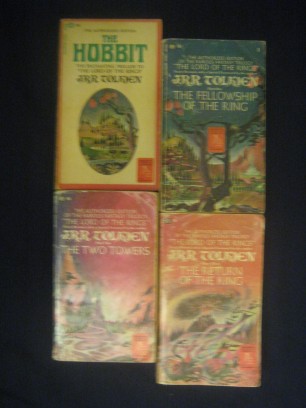 1st U.S. paperback editions (1965/1966, Ballantine, sm, Cat #U7039 (H – 287 p), #U7040 (FOTR – 527 p), #10534 (TTT – 447 p), #U7042 (ROTK – 544 p))
1st U.S. paperback editions (1965/1966, Ballantine, sm, Cat #U7039 (H – 287 p), #U7040 (FOTR – 527 p), #10534 (TTT – 447 p), #U7042 (ROTK – 544 p))
- This was the first paperback U.S. printing of The Lord of the Rings and the matching 1966 revised edition of The Hobbit. The LOTR books were published in response to the unauthorized Ace editions. I have two sets of this – the other one is a complete LOTR in the box, which is listed down below in the three volume sets. These are the copies of the books that I grew up with, complete with the psychedelic artwork from Barbara Remington (if you line up the three LOTR books they make one complete cover). The covers really have little to do with the books, but convey a sense of fantasy (and drugs) that I always enjoyed (plus, as I said, I grew up with them). As you can tell, I actually have a slightly mis-matched set, with Towers not really belonging. The Hobbit is an 8th printing from 1967, Fellowship is a 17th printing from 1968, Towers is a 24th printing from 1970 and King is a 14th printing from 1968. These aren’t in nearly as good a shape as my other set because the other set is a matching set in a box.
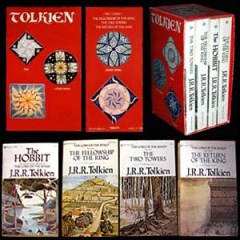 Ballantine – 2nd Issue (1973, Ballantine, sm, 0345248260 (H – 287 p), 0345272587 (FOTR – 527 p), 0345253442 (TTT – 447 p), 0345272609 (ROTK – 547 p))
Ballantine – 2nd Issue (1973, Ballantine, sm, 0345248260 (H – 287 p), 0345272587 (FOTR – 527 p), 0345253442 (TTT – 447 p), 0345272609 (ROTK – 547 p))
- First of all, it is entirely possible that I have a mismatched set given that the the ISBN for Towers is off from the others. But I had to buy these all separately over time. I also have them in a different box – the box I use is the gold version of the one shown in the picture (and though it lists The Hobbit, my copy doesn’t fit in the box – a constant thing is that books expand if not kept in the box, so if you fill a box with other copies, often you can’t get them all in). These copies were all done to a standard – the title on top, followed by Tolkien’s name, with the bottom half of the front cover taken up by the artwork – all of it by Tolkien. We have Bilbo on the Forest River on H, The Shire on FOTR, Fangorn on Towers and Barad-Dûr on King – the same illustrations that would be brought back for the 4th issue. These are the only paperback copies I am aware of though that have a picture of Tolkien on the back. The 1973 is the original date of this version – my Hobbit is a 54th printing from 75, Fellowship is a 65th from 1978, Towers is a 52nd from 1976 and King is a 59th from 1978.
 Ballantine – 3rd Issue (1981, Ballantine, mm, 0345296044 (H – 287 p), 0345296052 (FOTR – 527 p), 0345296060 (TTT – 447 p), 0345296087 (ROTK – 547 p))
Ballantine – 3rd Issue (1981, Ballantine, mm, 0345296044 (H – 287 p), 0345296052 (FOTR – 527 p), 0345296060 (TTT – 447 p), 0345296087 (ROTK – 547 p))
- These are my babies, the copy that I read every year from the time that I slowly found them and bought them in the late 80’s (I knew this was the set I wanted – it was the set both my brothers had) until they started to fall apart in the early 00’s and I started to buy other copies. Incredibly, for a long time, these were the bulk of my Tolkien collection. It wasn’t really until just before the films came out and I was working at Powell’s that I started to go bonkers with this collecting. These copies all go together – they all have that same cover design, with the Tolkien name on top, the title below, and then the bottom half using a picture taken from the 1982 Tolkien Calendar, all illustrated by Darrell K. Sweet. I actually keep them in the same kind of red box that is shown in the picture for the 2nd issue. My Hobbit is a 1st printing of the Revised Edition in 1982, Fellowship is a 75th printing from 1981, Towers is a 69th from 1981 and King is a 71st from 1983. These are also known as the Silver Jubilee Edition. Though I include the picture of The Silmarillion that goes along with this set, it is listed by title down below.
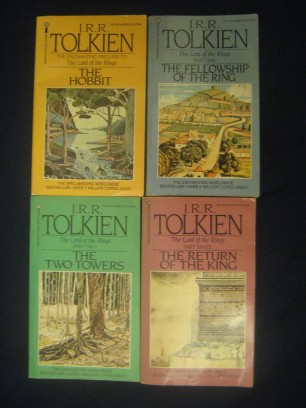 Ballantine – 4th Issue (1986, Ballantine, mm, 0345339681 (H – 287 p), 0345339703 (FOTR – 527 p), 0345339711 (TTT – 447 p), 0345339738 (ROTK – 544 p)
Ballantine – 4th Issue (1986, Ballantine, mm, 0345339681 (H – 287 p), 0345339703 (FOTR – 527 p), 0345339711 (TTT – 447 p), 0345339738 (ROTK – 544 p)
- Sometime around 1986, Ballantine decided to keep the same style that they had been using since 1982, but to change the covers slightly. It would still have one solid color (gold – H, blue – FOTR, green – TTT, red- ROTK), although it would fade them a pastel. It would still keep the scroll on the back, the design on the front and the illustration in the box. However, it would change the illustration. Instead of the Darrell K. Sweet illustrations that had been gracing the covers since 1981, it would now use original Tolkien illustrations for the covers, the same ones from the 2nd Issue. So now The Hobbit had Bilbo on the Forest River, Fellowship had The Shire, Two Towers had Fangorn and King had Barad-Dûr. Given how much I had loved the design for years of the 1981 editions, to have the same design, but with Tolkien illustrations was simply perfect. My copies are H (17th printing – 1986), FOTR (7th printing – 1986), TTT (82nd printing – 1986), and ROTK (79th printing – 1987). Though the covers would change constantly over the next 25 years, every edition since this one has continued to use the same ISBNs.
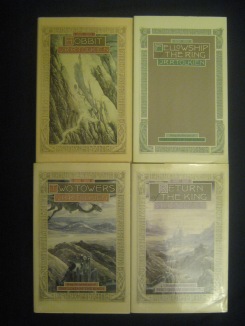 50th Anniversary Edition (1988, Houghton Mifflin Company, ss, 0395282659 (H – 255 p), 0395272238 (FOTR – 422 p), 039527222x (TTT – 352 p), 0395272211 (ROTK – 440 p))
50th Anniversary Edition (1988, Houghton Mifflin Company, ss, 0395282659 (H – 255 p), 0395272238 (FOTR – 422 p), 039527222x (TTT – 352 p), 0395272211 (ROTK – 440 p))
- I’m not quite sure what to think. Library Thing lists this as the 50th Anniversary Edition from 1988. However, my copies of TTT and ROTK have a small little emblem on the back listing them as part of the Centenary Edition. FOTR is incomplete because it is missing the dust jacket. Yes, I said dust jacket. These four books, in spite of being trade paperbacks actually have dust jackets. What’s more, the dust jackets have Alan Lee illustrations but the front covers of the book do not actually have the illustrations – they have the same design otherwise, but just diagonal lines where the Lee illustration is on the jacket. But they are nice paperback editions and The Hobbit includes the original Tolkien illustrations.
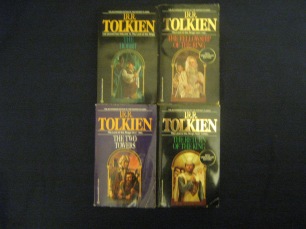 50th Anniversary Edition paperback (1989, Ballantine, mm, 0345339681 (H – 287 p), 0345339703 (FOTR – 527 p), 0345339711 (TTT – 447 p), 0345339738 (ROTK – 544 p))
50th Anniversary Edition paperback (1989, Ballantine, mm, 0345339681 (H – 287 p), 0345339703 (FOTR – 527 p), 0345339711 (TTT – 447 p), 0345339738 (ROTK – 544 p))
- For the first time in nearly a decade, Ballantine completely changed the covers, and not really for the better to my mind. The front cover of The Hobbit is a rather poor Bilbo, with a freakish Gollum, Fellowship has Gandalf and Frodo, Towers has Legolas (looking more like Thor than an elf) and Gimli while King has Aragorn and several people fawning at him from the background. The covers are all by Michael Herring. They also changed the design on the covers – the name Tolkien is in larger, bold letters, the artwork is in an archway with runes at the bottom and the illustrations also appear on the spine and the back. The background colors are all in black (I have a mis-matching Towers which isn’t in black). They also have 50th Anniversary Edition! printed in a circle on the cover. These would be the last editions to actually mention inside the printing date as opposed to just the copyright date (though H and TTT don’t have them): FOTR is a 15th printing from 1989 and ROTK is a 5th printing from 1989. In spite of all of these changes, these editions would keep the same ISBN as the previous printing.
 1999 edition (Houghton Mifflin Company, ss/sc, 0618002251 (set), 0618002219 (H – 272 p), 0618002227 (FOTR), 0618002235 (TTT), 0618002243 (ROTK))
1999 edition (Houghton Mifflin Company, ss/sc, 0618002251 (set), 0618002219 (H – 272 p), 0618002227 (FOTR), 0618002235 (TTT), 0618002243 (ROTK))
- For a long time I have had the box for this set and kept a variety of Tolkien related books in the box. However, in the last couple of years I actually picked up all the books in this set and so now have finally placed them all in a matching slipcase. The four volumes all feature covers by Alan Lee, though The Hobbit includes the original Tolkien illustrations.
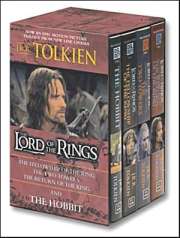 movie covers edition (2001, 2002, 2003, Ballantine/Del Rey, sm/sc, 0345340426 (set), 0345339681 (H – 287 p), 0345339703 (FOTR – 527 p), 0345339711 (TTT – 447 p), 0345339738 (ROTK – 544 p))
movie covers edition (2001, 2002, 2003, Ballantine/Del Rey, sm/sc, 0345340426 (set), 0345339681 (H – 287 p), 0345339703 (FOTR – 527 p), 0345339711 (TTT – 447 p), 0345339738 (ROTK – 544 p))
- This is where things get tricky. I have two complete movie cover sets and I have three boxes for them. Each box seems to have been released for a specific film. The green box seems to have been for Fellowship in 2001, the burgundy box for Towers in 2002 and the blue box for King in 2003 (the stills on the boxes seem to bear this idea out). Each box has a still on Frodo on the right and Aragorn on the left. But, oddly, the back side never has Gandalf – the Fellowship box has Saruman, the Towers box has Legolas and the King box has Éowyn. As for the covers, well, they can change as well. The Hobbit, since it didn’t have a film, was still using the Ted Nasmith cover that had come out in 1999. The Fellowship cover is black – I have one with a still of Frodo staring at Sting (which is the image from the Fellowship box), the other with Frodo being pulled by Gondorian soldiers (which is the image from the Towers box); the back covers differ as well, with Legolas in place of Saruman on the later printing and with a different Aragorn picture, though Galadriel is in the middle of both. Both covers of Towers have Legolas in Rohan armor and both use the same three photos on the back (the Frodo picture from the Towers box, Éowyn and the later Aragorn picture). One copy of King uses the same Frodo and Legolas pictures from Towers and a picture of Arwen. The other, which actually lists a 2003 copyright date for the photos, has a different picture of Frodo and Arwen and with Saruman rather than Legolas. So, it is all complete confusion and I’m not sure what goes with what and how it all works out, or if there even is a way to tell them all apart (the same problems exists with the movie covers for the trade editions listed below). Because I only have two sets and three boxes, I keep my mass markets of Vol II-V of HOME in the extra box.
3 Volume Sets:
With most of these sets, I don’t have boxes. That’s because a lot of these are mis-matched sets, ones I collected over time. Several of these have editions of The Hobbit that match them, but I don’t happen to have it, or it would be up above it. Anything that is in a box clearly doesn’t come with The Hobbit and is complete in and of itself.
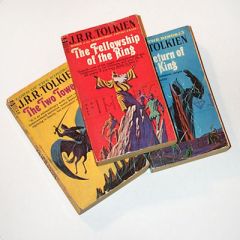 Ace Edition (1965, Ace Books, Inc., sm, A-4 (FOTR – 448 p), A-5 (TTT – 381 p), A-6 (ROTK – 444 p)
Ace Edition (1965, Ace Books, Inc., sm, A-4 (FOTR – 448 p), A-5 (TTT – 381 p), A-6 (ROTK – 444 p)
- These are the infamous Ace books, published in 1965. The owner of Ace argued that because Houghton Mifflin was printing its copies with pages set in the U.K. that LOTR was unprotected by copyright laws. So he printed this edition on his own. On the one hand, you can could say that he made accesible in paperback a book that many were longing for. On the other hand, because he had no rights to print it, he wasn’t paying Tolkien any royalties on the book. HM responded by authorizing the Ballantine editions with a box on the back from Tolkien urging people not to buy the unauthorized versions. Ace finally relented, letting their versions go out of print and paying Tolkien some royalties. As a result, these have been long sought after in spite of the fact that the books aren’t that well printed and the cover art (by Jack Gaughan) is kind of bizarre and to my mind not very good. But they are important touchstones in Tolkien publishing history, which is why when I had a chance, I bought the latter two books at a comic book store in Wakefield. It was a couple of years later when a co-worker at the Booksmith had put aside a book and asked me if I wanted it – when she saw the look on my face she thought I already had it, when in fact I was stunned that she had managed to get hold of the Ace copy of Fellowship – the one I didn’t have and that completed my set (thanks Andrea!).
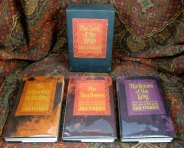 2nd U.S. Edition (1965, Houghton Mifflin Company, sh/sc, 423 p (FOTR), 352 p (TTT), 440 p (ROTK))
2nd U.S. Edition (1965, Houghton Mifflin Company, sh/sc, 423 p (FOTR), 352 p (TTT), 440 p (ROTK))
- These are 5th (FOTR) and 4th (TTT / ROTK) printings of the 2nd U.S. Edition, published in 1965 at the same time as the Ballantine edition to secure the copyright. These were the first editions to carry the Foreward. It seems to have been pretty standard to have mixed printings in one box, with a later printing of Fellowship. Obviously they pre-date the whole ISBN system and so don’t have them.
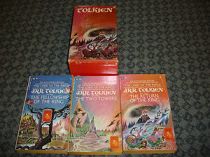 1st U.S. paperback set (1965, Ballantine, sm, Cat#59224 (set), #01533 (FOTR – 527 p), #01534 (TTT – 447 p), #01535 (ROTK – 544 p)
1st U.S. paperback set (1965, Ballantine, sm, Cat#59224 (set), #01533 (FOTR – 527 p), #01534 (TTT – 447 p), #01535 (ROTK – 544 p)
- This was the first paperback U.S. printing of Lord of the Rings, published by Ballantine (licensed by HM) in response to the unauthorized Ace editions. I actually have two sets of this (the other is listed up above in four volume sets). This set is complete in a box. Look up above to see a full description. These printings are 34th (FOTR), 30th (TTT), 29th (ROTK), all of them from 1971.
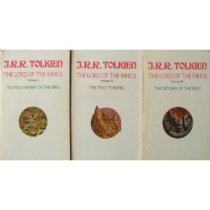 Ballantine boxed trade set (1975, Ballantine, ss/sc, 0345247868 (set), 527 / 447 / 544 p)
Ballantine boxed trade set (1975, Ballantine, ss/sc, 0345247868 (set), 527 / 447 / 544 p)
- This set, a rare trade paperback box set from Ballantine (usually they only did the mass market copies) is also one of the first trade paperback sets. But, interestingly, this is only available as a set. There are no individual IBSNs for the books – only one for the set and the books don’t have prices. Each individual copy only has a small design on the cover (quite minimalist) and for some reason the cover for The Two Towers seems to have Minas Tirith on it. But the cover for the set makes use of several small illustrations bunched around Tolkien’s map, with an illustration on top of the box that had previously appeared on the Canadian editions of the books, of the Fellowship from behind.
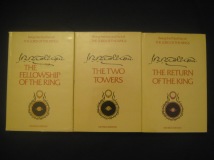 book club edition (1983, Houghton Mifflin Company, sh, 444 / 350 / 447 p)
book club edition (1983, Houghton Mifflin Company, sh, 444 / 350 / 447 p)
- Book club editions are notoriously difficult to pin down as to when they were released. It’s also hard to tell who printed it. It’s often easy to figure out a book club hardcover (they don’t have printed prices inside the dust jacket, they often say Book Club, and there will be a code marked in the book, usually on the last page of text. But the only thing I can tell about when it was printed is that it was at least 1983 or later because it has the renewed copyrights. I do rather like the dust jacket design on these books but they have no credit on them. Because the dust jackets reflect the design on the books themselves in the 1987 printing, these might be from more around that time and they seem to simply be hardcover editions of what HM was printing in trade.
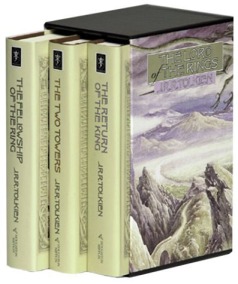 50th Anniversary of The Hobbit set (1987, Houghton Mifflin Company, sh/sc, 0395489326 (set), 0395489318 (FOTR – 423 p), 0395489334 (TTT – 352 p), 039548930x (ROTK – 440 p))
50th Anniversary of The Hobbit set (1987, Houghton Mifflin Company, sh/sc, 0395489326 (set), 0395489318 (FOTR – 423 p), 0395489334 (TTT – 352 p), 039548930x (ROTK – 440 p))
- This was a hardcover edition printed to coincide with the 50th anniversary of The Hobbit. The set itself and the individual books use Alan Lee art for the covers, some four years before most of these illustrations became a big selling-point in the Centenary Edition.
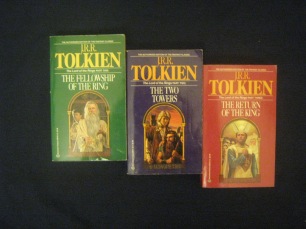 Ballantine Sixth Issue (1990, Ballantine, mm, 0345339703 (FOTR – 479 p), 0345339711 (TTT – 415 p), 0345339738 (ROTK – 507 p))
Ballantine Sixth Issue (1990, Ballantine, mm, 0345339703 (FOTR – 479 p), 0345339711 (TTT – 415 p), 0345339738 (ROTK – 507 p))
- On first glance, these would seem to be essentially the same as the 50th Anniversary Edition paperbacks, with the exception that instead of black, the colors range (green for FOTR, purple for TTT, red for ROTK). They have the same Michael Herring artwork and even the same ISBNs. However, there is a key change that is made here – they are repaginated. The entire time that Ballantine had been printing the books, beginning in 1965, all the way through to 1990, they had the same pagination – pick up any copy with several different ISBNs and covers and inside the same text is on the same page in every edition. For this one, with just a minimal cover change, they finally repaginated the whole books and they come out considerably shorter. They also changed the price point from $5.95 to $5.99. These were the copies still in print in 1999 when I first started working in bookstores. These were the first copies not to use printing dates, but rather only copyright dates. They would also be the first to change the style and fonts on the maps.
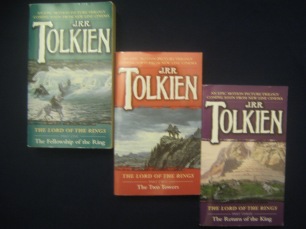 Ballantine/Del Rey 7th Issue (1999, Ballantine/Del Rey, mm, 0345339703 (FOTR – 479 p), 0345339711 (TTT – 415 p), 0345339738 (ROTK – 507 p))
Ballantine/Del Rey 7th Issue (1999, Ballantine/Del Rey, mm, 0345339703 (FOTR – 479 p), 0345339711 (TTT – 415 p), 0345339738 (ROTK – 507 p))
- These were the transition copies between the Michael Herring covers and the movie covers that started to come out in mid-2001. These all have artwork by Ted Nasmith (the scene at the Ford of Bruinen for Fellowship, Frodo and Sam in Emyn Muil for Towers, Gandalf riding to Minas Tirith for King). All of them have sort-of wrap-around covers, in that the front and back form one complete picture but the spine is not part of it (in fact the spine is just a small part of the front illustration). They have a new font for the author name (whose last name is much bigger). Each is a full solid color – teal for Fellowship, burgundy for Towers, purple for King. The late printings of these (like mine) also say “An Epic Motion Trilogy Coming Soon from New Line Cinema” at the top front of the book.
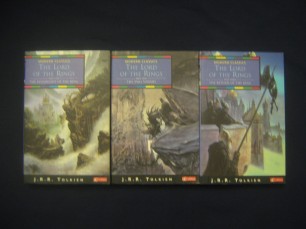 Modern Classic edition (2001, HarperCollins Publishers, ss, 000712970x (FOTR), 0007129718 (TTT), 0007129726 (ROTK), 1137 p)
Modern Classic edition (2001, HarperCollins Publishers, ss, 000712970x (FOTR), 0007129718 (TTT), 0007129726 (ROTK), 1137 p)
- This three volume set is a U.K. edition. They are smaller trade papers and some of the easiest copies to actually hold and read. They have three wonderful covers from John Howe – Rivendell (FOTR – though this scene seems to be more from The Hobbit), The Witch King (TTT) and Soldiers of Gondor (ROTK). This is one of those sets that uses continual pagination, making me think they came in a box at one point.
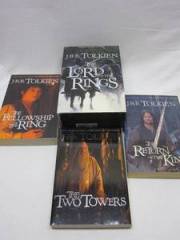 movie cover trade set (2001, Houghton Mifflin Company, ss/sc, 0618153969 (set), 0618129030 (FOTR), 0618129081 (TTT), 0618129111 (ROTK), 1137 p)
movie cover trade set (2001, Houghton Mifflin Company, ss/sc, 0618153969 (set), 0618129030 (FOTR), 0618129081 (TTT), 0618129111 (ROTK), 1137 p)
- This was the first box of trade paperbacks released to coincide with the films. Like the 1999 edition, the pages continue numbering through all three books of LOTR. Because of all the various covers that HM released during this stretch, with a variety of different ISBNs (see random volumes down below for a few more), it’s hard to tell exactly when any particular copy was released and whether a set has been mismatched at all. This set, at least, appears to go together, with various stills on the covers.
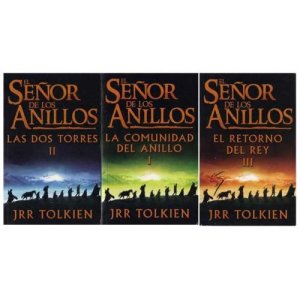 2001 Spanish-Language set (2001, Minotauro, tp, 9505470673 (FOTR – 547 p), 9505470657 (TTT – 462 p), 9505470665 (ROTK – 414 p))
2001 Spanish-Language set (2001, Minotauro, tp, 9505470673 (FOTR – 547 p), 9505470657 (TTT – 462 p), 9505470665 (ROTK – 414 p))
- I bought these in the hopes of forcing myself back into Spanish and because I’m a book-collecting freak. All three covers use the same still, which is a sillhouete shot from the first film of the Fellowship walking. Fellowship has a green background, Towers has a blue one and King has an orange one. The actual titles are La comunidad del anillo (Fellowship), Las dos torres (Towers) and El retorno del rey (King). Like El Hobbit, the Contents page is the last page. Also, there is only one appendix in ROTK – the tale of Aragorn and Arwen. These were originally printed in 1991, but these are clearly 2001 editions. These three actually follow (out-of-order, as often is the case) directly on the ISBNs for El Hobbit and El Silmarillion which I also have (see above and below). Fellowship is translated by Luis Doménech while the other two are translated by Doménech and Mathilde Horne. Fellowship is the only one of the three with maps.
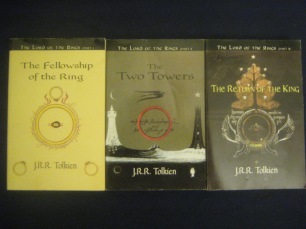 book club edition (2001, Quality Paperback Book Club, ss, 0965307751 (FOTR – 423 p), 0965307816 (TTT – 352 p), 0965307794 (ROTK – 440 p))
book club edition (2001, Quality Paperback Book Club, ss, 0965307751 (FOTR – 423 p), 0965307816 (TTT – 352 p), 0965307794 (ROTK – 440 p))
- For a book club edition, these are actually pretty well made. The paper is actually pretty good and they don’t just use the original book covers – in fact, they took Tolkien’s ideas for what he wanted on the original covers and did variations on those with Tolkien’s own illustrations, with a design by Grey Thornberry.
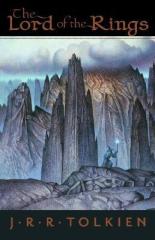 young adult set (2005, Houghton Mifflin Company, ss, 0618574999 (set), 0618574948 (FOTR), 0618574956 (TTT), 0618574972 (ROTK), 1438 p)
young adult set (2005, Houghton Mifflin Company, ss, 0618574999 (set), 0618574948 (FOTR), 0618574956 (TTT), 0618574972 (ROTK), 1438 p)
- This set (I call it the young adult set because the box lists it as belonging in Young Adult / Fantasy) has some odd designs. For one thing, while paginated as a set, it is paginated longer than any other version of the set, mainly because the type is bigger and in a different font than in most editions (the bigger type is probably why it is the young adult set – the bigger type looks less intimidating). The set covers are by John Jude Palencar. The box is also by Palencar, but actually has completely different designs than the books themselves, including an odd picture on the back spine that might be the Argonauth or might just be a good and evil soldier standing next to each other. The FOTR cover is Frodo and a Black Rider, TTT is either Pippin or Merry with Treebeard (though why not both I’m not certain) while ROTK is Aragorn among the Dead. But I’m not a big fan of any of it.
2 Volume Set:
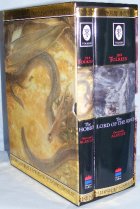 U.K. Alan Lee Illustrated Set (2000, HarperCollins Publishers, sh/sc, 0007105029 (set), 026110330x (H – 288 p), 0261102303 (LOTR – 1193 p)
U.K. Alan Lee Illustrated Set (2000, HarperCollins Publishers, sh/sc, 0007105029 (set), 026110330x (H – 288 p), 0261102303 (LOTR – 1193 p)
- This was not originally designed as a set. This set is the U.K. edition of the Alan Lee illustrated 1991 one volume edition, combined with the U.K. Edition of the Alan Lee illustrated 1997 version of The Hobbit. Both of them are beautifully illustrated and designed with matching spines on the dust jackets, to go along with a beautiful slipcase. The Hobbit, however, is wider than LOTR and so the slipcase is a little oddly designed to accomodate that. This edition, with the two books combined in the slipcase was published in 2000.
1 Volume Sets:
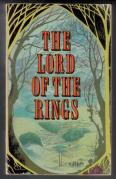 U.K. paperback (1968, George Allen and Unwin Ltd, tp, 0048230871, 1077 p)
U.K. paperback (1968, George Allen and Unwin Ltd, tp, 0048230871, 1077 p)
- This was the first one volume edition ever printed in paperback (my copy is a 9th impression – it says the one volume India Paper edition was first printed in 1969, and the paper is really thin, so this might an India Paper edition). One of the ways they saved on paper was that the only Appendix that they printed was the Tale of Aragorn and Arwen. The cover illustration is by Pauline Baynes. It is an odd illustration in that it seems to be depicting The Shire, yet has the entire Fellowship in a corner, looking down upon it. The back cover is also by Baynes, and seems to show Minas Tirith and Mount Doom. This edition also has the map of Middle-earth, broken up into several parts and placed part by part at the beginning of all the books; it has some strange type fonts on it I haven’t seen on other versions.
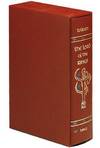 Collector’s Edition (1974, Houghton Mifflin Company, lt/sc, 0395193958)
Collector’s Edition (1974, Houghton Mifflin Company, lt/sc, 0395193958)
- A year after HM printed The Hobbit bound in green leather in a green leather slipcase, they followed it with this edition of Lord of the Rings bound in red leather in a red leather slipcase. It is one of the best looking editions, though it lacks in that it doesn’t have any illustrations. Let’s be straight – this is definitely one edition that you buy to look absolutely gorgeous on your shelf, rather than to read. It is also one of those annoying books that prints separate page numbers for all three books even though they are in volume.
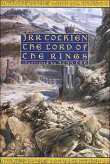 Tolkien Centenary Edition (illustrated by Alan Lee, 1991, Houghton Mifflin Company, hc, 0395595118, 1193 p)
Tolkien Centenary Edition (illustrated by Alan Lee, 1991, Houghton Mifflin Company, hc, 0395595118, 1193 p)
- This is the book that really made Alan Lee the pre-eminent Tolkien illustrator. This large (and expensive – $70 when originally released) edition is full of Lee’s illustrations, almost one per chapter. The cover is Lee’s illustration of The Black Gate Opens. Unfortunately, it is not what one would call a readable edition, unless you want to read it slowly at a desk. Definitely not a copy to take on the T.
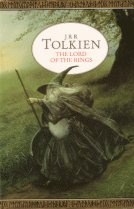 1994 U.K. reset edition (HarperCollins Publishers, hc, 0261103202, 1137 p)
1994 U.K. reset edition (HarperCollins Publishers, hc, 0261103202, 1137 p)
- You know that Note on the Text that appears in a lot of current 1 volume editions? That comes from this book, when the text was reset (just like on the copyright page that so many mention that the first printing of that edition was in the United Kingdom in 1994 by HarperCollins Publishers). This is a very nice copy, not only because it is a bit smaller for a hardcover and so not excessively heavy, but also because it has a beautiful John Howe illustration of Gandalf on the cover (I have the same illustration in my Tolkien corner). On the spine of the book itself, where the picture of Gandalf is on the jacket is a much larger version of the Tolkien symbol.
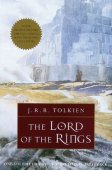 1 Volume U.S. paperback (1999, Houghton Mifflin Company, tp, 0395974682, 1137 p)
1 Volume U.S. paperback (1999, Houghton Mifflin Company, tp, 0395974682, 1137 p)
- “One Volume Edition” – “First Time in Paperback” And that does seem to be the case. While the Brits had been publishing LOTR in paperback since 1968, it had never been published as such in the States. Because his illustrations had been such a hit in the hardcover edition, they used an Alan Lee illustration for the cover (Minas Tirith). My copy might be a slightly later printing since it has embossed on the cover “An Epic Motion Picture Trilogy Coming Soon from New Line Cinema.”
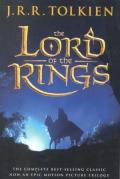 2001 Movie Cover (Houghton Mifflin Company, tp, 0618129022, 1137 p)
2001 Movie Cover (Houghton Mifflin Company, tp, 0618129022, 1137 p)
- The cover is a still from Fellowship of the Ring of the Black Rider in the Shire, up on the hill. I had a copy of this at one point and lent it out (deciding it was my least valuable copy) and never got it back. So I recently got this one again and decided that it was the best choice for making my notations for my Top 100 Novels post, because it is again one of my least valuable and because, with it being a one volume edition, it would be easier to reference when getting all the quotes (and as a trade edition, easier to hold open than a mass market).
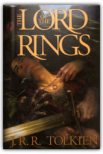 SFBC Edition (2001, SFBC, xh, 0739408259, 1137 p)
SFBC Edition (2001, SFBC, xh, 0739408259, 1137 p)
- Though this book club edition says that it is published by Houghton Mifflin Company, it is not. It published by SFBC (which I assume stands for Science Fiction Book Club) using some odd plates. The title page says Houghton Mifflin. The page opposite lists the History of Middle-earth series, but does not include the last book, even though it had long been printed by the time this edition was published. The front cover is by Donato, and is a bit odd, as it appears to be Sam holding Frodo, yet that seems to be Gollum’s hand reaching up. I assume this was aimed either at obsessive collectors (hello!) or at people who wanted a really cheap edition, because a hardcover 1137 page copy isn’t the most readable edition.
 U.K. Movie Cover (2002, HarperCollins Publishers, hc, 0007149131, 1137 p)
U.K. Movie Cover (2002, HarperCollins Publishers, hc, 0007149131, 1137 p)
- A smaller compact hardcover edition, with a thin see-through dust jacket with the Fellowship poster (of the Argonauth). If it wasn’t for the dust jacket, this would actually probably be the easiest to read hardcover edition I own. And I must admit, even with the kind of strange dust jacket, it is still a pretty cool one.
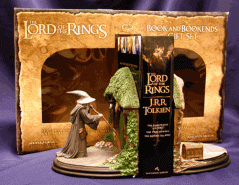 2003 Movie Cover with bookends (Houghton Mifflin Company, hc, 0618260242, 1137 p)
2003 Movie Cover with bookends (Houghton Mifflin Company, hc, 0618260242, 1137 p)
- This book, a hardcover edition with a gorgeous shot of Rivendell on the cover came with the Bookend gift set (0618401210). These were an absolutely magnificent set of bookends, with Gandalf on one side knocking on the door to Bag End, and Bilbo answering it on the other. The interesting thing is that every other copy of this ISBN has Gandalf on the cover – apparently the Rivendell dust jacket only came with the version of the book included in the bookend set.
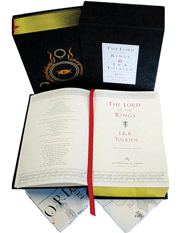 50th Anniversary Edition (2004, Houghton Mifflin Company, hc/sc, 0618517650, 1157 p)
50th Anniversary Edition (2004, Houghton Mifflin Company, hc/sc, 0618517650, 1157 p)
- Houghton Mifflin calls this edition the finest they’ve ever produced and they are probably right. It has gold gilded page edges, images of Tolkien’s paintings of the leaves from the Book of Marzabul, red text for the inscription on the ring, a nice slipcase and a wonderfully designed front cover. I had originally not gotten this edition, but was at HM in 2007 bringing over a delivery of things ordered from Borders. I got talking to the manager I was delivering to and mentioned that I was a big Tolkien fan. She pointed to this in her office and asked me if I had out and I mentioned that the $85 price tag was a little hefty for me. She gave me the copy on her shelf. Right place, right time, total luck. A gorgeous book that I am lucky to have.
 Indian paperback (2005, HarperCollins Publishers, fl, 9780007273508, 1178 p)
Indian paperback (2005, HarperCollins Publishers, fl, 9780007273508, 1178 p)
- This edition appears to have been printed in India (it says so inside, Printed and Bound at Thomson Press (India)) and also printed for India, as the price on the cover is in rupees. The cover is fairly cool, not for the illustration (based off the old British hardcovers), but for the fact that they are flexible hardcovers and they actually unfold into the maps – the main Middle-earth map in the front cover and the Gondor / Mordor map in the back cover. It is shorter than the average trade paperback and the paper seems to be a bit cheaper. Also, it says 2005, but unless India went to 13 digit ISBNs earlier than the U.S., this was printed in 2007 or later.
7 Volume Set:
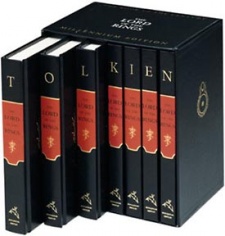 Lord of the Rings: The Book of the Century: Millenium Edition (1999, Houghton Mifflin Company, sh/sc, 0618037667):
Lord of the Rings: The Book of the Century: Millenium Edition (1999, Houghton Mifflin Company, sh/sc, 0618037667):
- This set is the only one I have ever seen that actually breaks up the Lord of the Rings into seven different volumes – one for each book and then a separate one for the appendices. Because each book has the same cover (based off the old U.K. editions), I have not included separate pictures of them all. The one difference is that each volume has the title printed in small print on the front cover and each spine has one letter, so when in the slipcase, they spell out TOLKIEN. The seven volumes also use the original names that Tolkien gave to each book and they are as follows:
- Book One: The Ring Sets Out (0618042202, 283 p)
- Book Two: The Ring Goes South (0618042210, 253 p)
- Book Three: The Treason of Isengard (0618042229, 252 p)
- Book Four: The Ring Goes East (0618042237, 189 p)
- Book Five: The War of the Ring (0618042245, 197 p)
- Book Six: The End of the Third Age (0618042253, 182 p)
- Appendices (0618042261, 180 p)
Random Individual Books:
These are random copies of the various Lord of the Rings books that I have that aren’t part of a complete set. Because it can be so hard to complete a set, I try not to buy individual books. But I have ended up with a handful of them.
- Ballantine Editions:
- My 3rd Issue Ballantine editions started to fall apart early in this century (especially Fellowship) because I had been reading them every year since I bought them in the late 80’s. So I decided to start replacing them with the same copies (I also decided that every year from now one I would read a different copy -I have more than enough to do so). So, I began buying new copies of the Ballantine. Except, well, even though Ballantine and Del Rey now constantly reprint the books with new covers but the same ISBN, they didn’t used to do that. So, I bought new Ballantine editions with the same 1982 Tolkien Calendar covers for Fellowship and King (and another one for King – I don’t know how that happened). Except, even though they are the same covers, they aren’t the same editions and same ISBNs. So, I have an extra copy of King, which is the same ISBN. But, the other copy of King and the copy of Fellowship are from a later printing with a different ISBN. The only difference appears to be that on the later editions the text on the front cover and spine is white instead of black and the price went up a dollar. And while there is no picture of the 1984 King because it is the same as the 3rd Issue up above, the 1985 King isn’t here because I literally couldn’t find a picture of it.
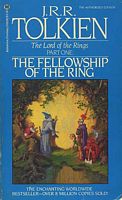 Fellowship of the Ring (1985, Ballantine, mm, 0345332083, 527 p, 5th printing, supposedly, but that can’t be right)
Fellowship of the Ring (1985, Ballantine, mm, 0345332083, 527 p, 5th printing, supposedly, but that can’t be right)- Return of the King (1984, Ballantine, mm, 0345296087, 544 p, 73rd printing)
- Return of the King (1985, Ballantine, mm, 0345332091, 544 p, 76th printing)
- Movie Trade Covers:
- I bought all three of these copies on the cheap at work because they had been sitting for a while. I bought them thinking I had a complete set. However, after looking at the ISBNs, it turned out the copy of Towers is from a different set (and is slightly taller). So I have the following:
 Fellowship of the Ring (2003, Houghton Mifflin Company, tp, 0618346252)
Fellowship of the Ring (2003, Houghton Mifflin Company, tp, 0618346252) The Two Towers (2002, Houghton Mifflin Company, tp, 0618260277)
The Two Towers (2002, Houghton Mifflin Company, tp, 0618260277) The Return of the King (2003, Houghton Mifflin Company, tp, 0618346279)
The Return of the King (2003, Houghton Mifflin Company, tp, 0618346279)
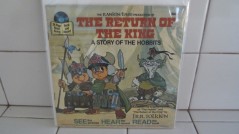 The Return of the King: A Story of the Hobbits 24 Page Read-Along Book and Record (1980, Disneyland / Vista Records)
The Return of the King: A Story of the Hobbits 24 Page Read-Along Book and Record (1980, Disneyland / Vista Records)
- As mentioned above, this was something Disney used to do – these 24 page books that had records to go along with them, so you could learn to read. Like The Hobbit, this is illustrated with stills from the Rankin / Bass film (I talked about it here as well). I had thought that John Huston himself did the narration, because, well, I was a kid, and it was a long time ago. But whoever the unknown narrator is, he does more than a passable job of doing Huston’s rendition of Gandalf from the film, certainly well enough to fool me when I was a kid and was unable to watch the films, but instead had to make do with the book and record. I brought this up recently while watching “Comic Book Men” with Veronica, in which Walt pays an obscene amount of money for a toy he had as a kid (Marvel World). I wouldn’t need to do that, I told V, because I still have all those types of things I loved as a kid – this being a perfect case in point (I had just reviewed this film earlier that day).
Audio Books:
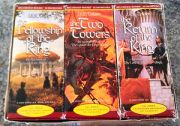 The Lord of the Rings Unabridged (1990, Recorded Books, 1402505205 – cassette, 1402516274 – CD)
The Lord of the Rings Unabridged (1990, Recorded Books, 1402505205 – cassette, 1402516274 – CD)
- This is the complete book, covering 52 hours (33 cassettes or 46 CDs). It is all narrated by Rob Inglis, who does a decent job. But he doesn’t do enough to distinguish the individual characters and I have never been able to get through the entire set. The cover art for Fellowship and Towers are by The Brothers Hildebrant while the cover for King is by Rowena Morrill.
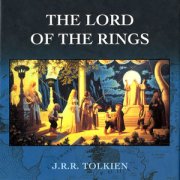 The Lord of the Rings BBC Dramatization (1999, Bantam Doubleday Dell Audio Publishing, 0553456539)
The Lord of the Rings BBC Dramatization (1999, Bantam Doubleday Dell Audio Publishing, 0553456539)
- If you are going to listen to LOTR rather than actually read it, then this is the one to get. For one thing, this isn’t just an audiobook – it’s a BBC dramatization made for radio in 1981. For another thing, it’s got a superb cast. I’m not a big fan of Michael Hordern as Gandalf, but the casting of Ian Holm as Frodo is perfect (there’s a big reason why he was chosen to play Bilbo in the Jackson films – because he was so effective here). Also, while Holm has long been acknowledged for his work here, someone who was much less well known back then but isn’t now is Bill Nighy (credited here as William Nighy) who does a great job as Sam. The series takes up 13 CDs and the cover art is by The Brothers Hildebrant.
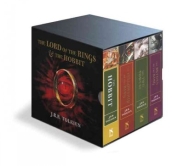 The Lord of the Rings and The Hobbit (2002, HighBridge, 1565117077)
The Lord of the Rings and The Hobbit (2002, HighBridge, 1565117077)
- This is a highly abridged version, covering only 15 hours on 13 CDs. Again, I have never been able to get through the entire thing. It is fully dramatized, but not very well. The cover art for all four disc sets is by John Howe, including the awesome Gandalf and Balrog illustration for Fellowship. Amusingly, the cover for King uses the Witch King illustration that HarperCollins put on their Modern Classics cover of Towers.
The Silmarillion:
The Silmarillion is probably the thing that keeps a lot of people from becoming hard-core Tolkien fans. Because this is the creation tale and it is written like a creation tale – it feels like something out of The Bible. And there are people who take to it far more, preferring this tale. One of my old bosses, at the annual Square Deal Sale at Powell’s used to put The Bible on the Fiction table and put this on the Non-Fiction table. Knowing it was so daunting, I deliberately didn’t read it until my senior year of college. I don’t go back to it that often, but it still stirs me occasionally. The same boss once put the audio on in our workspace on shuffle. It drove almost everyone insane. The fun of working at Powell’s.
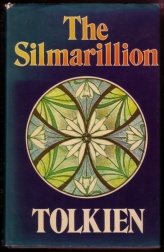 1st Edition (1977, George Allen & Unwin, hc, 0048231398, 365 p)
1st Edition (1977, George Allen & Unwin, hc, 0048231398, 365 p)
- This is the 1st printing of The Silmarillion, the U.K. edition. I bought it at the LA Antiquarian Book Fair back in 2002, as I was there for work and it was the only thing I really wanted that I could afford to buy for myself (I spent over $5000 of Michael Powell’s money on Richard Burton books). The front cover is the emblem of Lúthien Tinúviel. The back cover has more emlbems – those of Fingolfin, Eärendil, Idril Celebrindal, Elwë and Fëanor, all of which were designed by Tolkien.
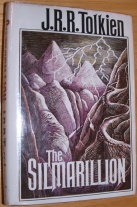 1st U.S. Edition (1977, Houghton Mifflin Company, hc, 0395257301, 365 p)
1st U.S. Edition (1977, Houghton Mifflin Company, hc, 0395257301, 365 p)
- This is my copy of the U.S. edition (also a 1st). My parents had this book growing up and I always thought it odd that they had a hardcover of it. Once I went to work in the used book industry and began to discover how to distinguish between editions, I noticed that my parents copy was actually a book club copy. The front cover illustration, which I have always associated with this book because of our copy growing up, is by Tolkien, but it actually was done for The Hobbit. But since it doesn’t include any of the characters, it also seems to work well for The Silmarillion.
 1st mass market (1979, Ballantine, mm, 0345272552, 458 p)
1st mass market (1979, Ballantine, mm, 0345272552, 458 p)
- I had never seen this until I bought it sometime in the last couple of years. This is the 1st Edition of the original mass market printing, complete with the original Tolkien illustration that has become so well-known from being the 1st U.S. edition cover, though here it is billed as J.R.R. Tolkien’s The Silmarillion.
 1983 edition (Houghton Mifflin Company, tp, 0395346460, 365 p)
1983 edition (Houghton Mifflin Company, tp, 0395346460, 365 p)
- This is a 9th printing of the 1983 edition. For this edition, they made the map be the front and end papers of the book. The cover illustration is by Tolkien, but it is obviously different from the Tolkien illustration that they used on the hardcover. It’s a design I had never seen before I bought it and the ISBN has since been re-used for other editions.
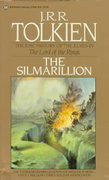 Ballantine mass market (1984, mm, 0345325818, 458 p)
Ballantine mass market (1984, mm, 0345325818, 458 p)
- This is the other edition (aside from the 1st U.S.) that I grew up with – the mass market version that goes along with the 4 volume set listed above. Sometime after the 1982 Tolkien Calendar (with illustrations from Darrell K. Sweet) went to press, Ballantine decided to use images from it for the covers of all the books – the one here is The Fall of Númenor. It goes with the set I have owned the longest, the Ballantine 3rd Issue. This is the first copy that I actually read, though I owned it for many years before I actually read it in the Spring of 1996. Probably the only books on this page I have owned longer are my Ballantine set of LOTR and The Hobbit, The Complete Guide to Middle-earth and my two 24 page book and record sets.
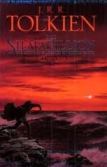 1998 illustrated edition (illustrations by Ted Nasmith, hc, 0395939461, 365 p)
1998 illustrated edition (illustrations by Ted Nasmith, hc, 0395939461, 365 p)
- This new hardcover edition is beautifully illustrated by Ted Nasmith. And I mean beautiful – these are some of my favorite drawings of Middle-earth, even though I don’t have the some emotional connection I have to characters in LOTR (or perhaps because of that). The front cover is Nasmith’s depiction of Maglor casting a silmaril into the sea, while the back cover is “Beren and Lúthien Carried to Safety.”
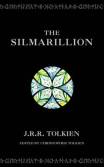 Tolkien Collection (1999, HarperCollins Publishers, mm, 9780261102736, 443 p)
Tolkien Collection (1999, HarperCollins Publishers, mm, 9780261102736, 443 p)
- In 1999, HarperCollins decided to publish 8 books with matching dust jackets (Hobbit, Fellowship, Towers, King, Silmarillion, Unfinished Tales, Roverandom, Tales from the Perilous Realm). All of them have black backgrounds and artwork from Tolkien on the front, while the Tolkien symbol appears on the spine, followed by the title, a small version of the artwork, and the author’s name. This is the only one I have aside from The Hobbit so far. This is also a printing of the 2nd Edition of The Silmarillion. This copy was clearly printed in at least 2007 or later because of the 13th digit ISBN, but I don’t know precisely when (it’s a 53rd printing).
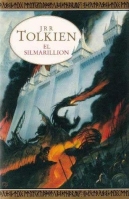 El Silmarillion (2001, Minotauro, tp, 9505470649, 432 p)
El Silmarillion (2001, Minotauro, tp, 9505470649, 432 p)
- The Spanish language edition. Like Hobbit, and LOTR, originally printed in 1991, this is a 2001 printing. Like the above books, the Contents is the last page and it is part of the matching ISBNs (though it comes before LOTR rather than after). Unlike the other editions, there are no oddities about the maps in this book. The cover is by John Howe – the cover art and the binding make it match well with El Hobbit on the shelf. The translation is by Rubén Masera and Luis Doménech.
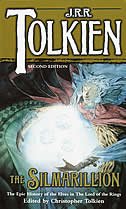 2nd Edition paperback (2002, Ballantine/Del Rey, mm, 0345325818, 442 p)
2nd Edition paperback (2002, Ballantine/Del Rey, mm, 0345325818, 442 p)
- This is the first Del Rey edition of 2nd Edition of The Silmarillion, which was published in 1999 and included several corrections that Christopher Tolkien had made. The cover art is by Michael Dringenberg. Annoyingly, as you can see, it uses the exact same ISBN that Ballantine had been using since the early 80’s, even though the cover was completely different, it was a different edition and it now cost almost twice as much. I actually have two copies of this book because I forgot I had it – one of them is the 1st printing, the other is the 40th
Unfinished Tales of Númenor and Middle-earth:
I am never quite certain where to keep my copy of this book. It often, due to space, ends up with the miscellaneous Tolkien books. I always forget that it is not a part of The History of Middle-earth. But, this was in fact the bridging work between the publication of The Silmarillion and the further books that would follow. The publication of this book in 1980 was so successful that it made it clear that the market for Tolkien was not diminishing, but in fact, expanding. Thus, a few years later began the publication of The History of Middle-earth. But this was the first book, and it has very valuable parts to it, including “The Quest of Erebor” and “The Istari”. If you love The Lord of the Rings but are daunted by either The Silmarillion or by working your way through the whole history of its writing, this is the additional book that you need to pick up.
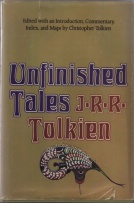 1st U.S. Edition (1980, Houghton Mifflin Company, hc, 0395299179, 472 p)
1st U.S. Edition (1980, Houghton Mifflin Company, hc, 0395299179, 472 p)
- The 1st American Edition of the book. The cover design is by Louise Noble with a drawing from Tolkien. I actually have two copies of the 1st American Edition. The first one that I bought is missing the dust jacket and has been water-damaged but it still has the map. The second has the dust jacket and is in much better shape, but is, however, missing the fold-out map in the back.
- paperback edition (1982, Houghton Mifflin Company, tp, 0395324416, 472 p)
- This is the first paperback edition, using the same cover as the 1st Edition (so no picture).
 mass market edition (1988, Ballantine, mm, 0345357116, 493 p)
mass market edition (1988, Ballantine, mm, 0345357116, 493 p)
- This is the 30th printing of the 1988 first mass market edition. The cover is by Michael Herring and is the same style as The Hobbit and LOTR sets that would follow in 1989, with the archway and runes and a Herring illustration within.. It’s hard to tale the precise date of this book. It only lists five volumes of History, yet the 6th volume was published in 1987, a year before the edition date.
 2001 edition (Houghton Mifflin Company, tp, 0618154051, 472 p)
2001 edition (Houghton Mifflin Company, tp, 0618154051, 472 p)
- In 2001, just before the movies were coming out, HM released new editions of Unfinished Tales simultaneously in hardcover and paperback (with identical covers from Ted Nasmith).
The History of Middle-earth (ed. Christopher Tolkien):
This series was published by Christopher Tolkien between 1984 and 1996. It consists of 12 volumes, with the first five now generally collected as The Histories of Middle-earth and the next four as The History of the Lord of the Rings. They would cover the entire breadth of his father’s work on Middle-earth, from the first writings in the early part of the century all the way until his death. While the editorial decisions and commentary is by Christopher, the bulk of the written material in the 12 volumes is Tolkien’s own original writing.
- The Book of Lost Tales Part I (Volume I)
- This was the first book in the History of Middle-earth. While the cover and the list of titles in the series write out the word “One” in the title, the title page itself uses the Roman numeral. Because the series covers Tolkien’s writings chronologically, and because so much of his early writing dealt with the First Age of Middle-earth, all of the material in this book deals with things from that era, so this was suited much more for serious fans who had done well with The Silmarillion than for the casual LOTR fan.
 1st U.S. Edition (1984, Houghton Mifflin Company, hc, 0395354390, 297 p)
1st U.S. Edition (1984, Houghton Mifflin Company, hc, 0395354390, 297 p)
- This book set the standard for how Houghton Mifflin would do the jacket designs for the first five books in the series. The front cover has the phrase The History of Middle-earth at the top, just above Christopher Tolkien’s name, neither in particularly big type. Then, just below and to the right is the Tolkien symbol. Starting just below that, to the left, is the title in large bold all-caps, with Tolkien’s name just below, in slightly smaller print. The back of the cover would have a blurb with the ISBN below it in a small white box (these were the days before barcodes on hardcover books). Every dust jacket would also be a complete solid color – in this case a forest green. The inside would list the series, opposite the title page. In this volume, both Volumes II and III are listed as in preparation. In this book, as with all the subsequent titles, The History of Middle-earth would not actually appear on the title page. On this book, the volume number for the series appears nowhere on the front cover.
- 1st U.S. paperback (1986, Houghton Mifflin Company, tp, 0395409276, 297 p)
- The first paperback edition has exactly the same cover as the dust jacket of the 1st Edition (thus no picture). The only difference is that it now has the Don Sakers review blurb (that would appear on the hardcovers of later books) and it no longer lists Volumes II and III as in preparation, but rather as out and with Volume IV in preparation.
 1992 Ballantine/Del Rey Edition (mm, 0345375211, 345 p)
1992 Ballantine/Del Rey Edition (mm, 0345375211, 345 p)
- This was the first book in The History of Middle-Earth series to join the Ballantine imprint (it’s a Del Rey Book printed by Ballantine, making it, I believe, the first Tolkien book to be printed with the Del Rey imprint on it), and it wasn’t until 1992 – a decade after it was first published and in the middle of the series initial hardcover publication. Like with LOTR and The Hobbit, Ballantine would re-use this ISBN for later printings of the book with over covers. This cover art is done by John Howe. Like the others in the series would be, it has a helmet illustrated on the front and the back. On the back helmet would be a large number, indicating its place in the series.
- The Book of Lost Tales Part II (Volume II)
- The contents for this second book in the series (published shortly after the first one) are similar to the first one and deal with the same time period.
 1st U.S. Edition (1984, Houghton Mifflin Company, hc, 0395366143, 385 p)
1st U.S. Edition (1984, Houghton Mifflin Company, hc, 0395366143, 385 p)
- Stylistically, the dust jacket to this book is the same as the first one. The only difference is that the solid color in the background is cranberry. Like the first book, the volume number for the series does not appear on the front cover and on the list of titles in the series opposite the title page, it lists the next two books in the series as under preparation. There are two blurbs on the back of this book, the first by Don Sakers from the Baltimore Sun. This same blurb would appear on the back of the next two books in the series.
- 1st U.S paperback (1986, Houghton Mifflin Company, tp, 0395426405, 385 p)
- As with Volume I, the paperback is identical to the original hardcover dust jacket, with the exception of the volumes – this time it lists III and IV as being released. It lists Volume V as “In Preparation” though it doesn’t list it at all inside the book. My copy of this is clearly a later printing, as it is about a half inch shorter than my other two trade paperbacks and it is priced at $17 – much higher than I ($8.95) and III ($13.95), and indeed, even higher than the original price of II in hardcover ($16.95).
 1992 Ballantine/Del Rey Edition (mm, 034537522x, 391 p)
1992 Ballantine/Del Rey Edition (mm, 034537522x, 391 p)
- The second part of Book of Lost Tales was published by Ballantine/Del Rey at the same time that the first was. This version, like its predecessor would have its ISBN re-used at a later date (neither one currently uses this cover), has the helmet illustrations with the series number inside it on the back and has John Howe art. This book is interesting in that it is the only one of the Ballantine/Del Rey History books not to have a significantly higher page count than the original hardcover.
- The Lays of Beleriand (Volume III)
- This third book in the series, coming a year after the first two, deals with much of the same time period as the first two books. This book also includes a commentary on part of it by C.S. Lewis made in 1929, long before either Lewis or Tolkien had become famous.
 1st U.S. Edition (1985, Houghton Mifflin Company, hc, 0395394295, 393 p)
1st U.S. Edition (1985, Houghton Mifflin Company, hc, 0395394295, 393 p)
- This book has the same style of dust jacket as the first two volumes, using cornflower (Veronica’s word, not mine) as the background color and the same Sakers blurb on the back. This is the first book to start including the volume number on the front cover of the book (though they still wouldn’t be used on the title page). Because the publication started to get spaced out a bit more, there is only one volume as listed in preparation. This is also the first book to list the volumes on the back cover. The first page in the book is actually a facsimile of Tolkien’s hand-written copy of Lay of Leithian (the poem which Lewis comments upon).
- 1st U.S. paperback (1988, Houghton Mifflin Company, tp, 0395486831, 393 p)
- As with the first two, this book has the same stylistic design as the hardcover dust jacket. It does not list a paperback publication date inside (this was around the time they stopped doing such things most of the time), but on the back of the book it does list The Return of the Shadow with (1989 publication) listed after it, which is odd, since that book was actually published in 1988. I’m guessing that it maybe got pushed up from its original publication date. So this might have been published originally in 1987. LibraryThing lists it as a 1988 publication, but they also list it as a Mariner Books publication, which is stated nowhere on the book.
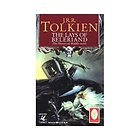 1994 Ballantine/Del Rey Edition (mm, 0345388186, 465 p)
1994 Ballantine/Del Rey Edition (mm, 0345388186, 465 p)
- The third book to be given the Ballantine/Del Rey treatment. Much the same as above, with an ISBN later re-used, with the series number in the helmet on the back of the book and with John Howe art. While the two books of Lost Tales give the series number, this is the first book to actually say The History of Middle-earth on the front cover.
- The Shaping of Middle-earth: The Quenta, The Ambarkanta and The Annals together with the earliest ‘Silmarillion’ and the first map (Volume IV)
- As the title indicates, this book starts to move away from the simple beginnings of the creation of the mythology to an actual full story, with the earliest fragments of what would later come to be The Silmarillion.
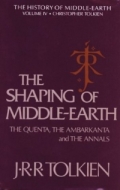 1st U.S. Edition (1986, Houghton Mifflin Company, hc, 0395425018, 380 p)
1st U.S. Edition (1986, Houghton Mifflin Company, hc, 0395425018, 380 p)
- This fourth volume follows the same standard for the dust jacket – volume number now included at the top, with a bluish-purple color used for the background. Because of the length of the title (though only The Shaping of Middle-earth was used), the Tolkien name and symbol on the spine are considerably smaller than they were on the first three books. While it lists the next volume as being in preparation on both the back cover and opposite the title page, it only gives the title of the next volume (The Lost Road and Other Writings) inside the book – the back simply says “In Preparation”.
 1995 Ballantine/Del Rey Edition (mm, 0345400437, 471 p)
1995 Ballantine/Del Rey Edition (mm, 0345400437, 471 p)
- The fourth book in the Ballantine/Del Rey series. As with above, the ISBN would later be re-used for an edition with vastly different cover art, it has the helmet design with the series number on the book and uses John Howe art On this one, unlike the others, there is no art on the back other than the helmet design (possibly because the description box is so much bigger). While the map in the original hardcover had been on regular paper, here the maps are set in the center of the book and printed on glossy paper.
- The Lost Road and Other Writings: Language and Legend before ‘The Lord of the Rings’ (Volume V)
- This fifth book helps bridge the gap between the writings that would create the Silmarillion and the writings that would eventually culminate in the publication of The Lord of the Rings. Because the History of Middle-Earth series doesn’t focus on the writing of The Hobbit, there is a gap here, as we don’t see its construction in relation to the other writings going on at the time.
 1st U.S. Edition (1987, Houghton Mifflin Company, hc, 0395455197, 455 p)
1st U.S. Edition (1987, Houghton Mifflin Company, hc, 0395455197, 455 p)
- This is the final book to use the original dust jacket design (with the background color this time being an olive green). Even though only the title The Lost Road appears on the spine, the Tolkien name and symbol are still the reduced size that they were on Volume IV. This is the first volume since I to not use the Sakers blurb on the back, rather having a blurb from David Bratman of Mythprint (a blurb that covers the first four books). Like the fifth book, the title of the next volume is listed inside the book, on the back of the book it simply says “In Preparation”.
 1996 Ballantine/Del Rey Edition (mm, 0345406850, 503 p)
1996 Ballantine/Del Rey Edition (mm, 0345406850, 503 p)
- The fifth and last book to be released in the Ballantine/Del Rey series. While these are the five books that would be contained in the Histories of Middle-earth box set (0345466454), this would not be released until 2003 and would use the later covers for the series. Like the previous books in the series, the cover art is by John Howe.
- The Return of the Shadow: The History of the Lord of the Rings, Part One (Volume VI)
- This was a very big deal when it first came out and it was initially confusing to someone like me who was only 14 at the time. The way it was first discussed, especially with this title, it almost seemed like this was a sequel to the events of Lord of the Rings. But this is the first volume in the history of writing The Lord of the Rings and one of the single most useful books I have ever read in delving into the writing mind. While there are so many books about writing and so many literary biographies that try to delve into the mind, the best evidence is what we have here – how the author began and began and began and how he changed things and how his creative process worked. It is so very different than what would eventually be published, with vastly different characters (and names) and events. And, it may just be that I am used to the name and might have been the same with another name, but personally I am really glad that Tolkien went with the name Frodo over the name Bingo.
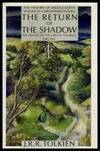 1st U.S. Edition (1988, Houghton Mifflin Company, hc, 0395498635, 497 p)
1st U.S. Edition (1988, Houghton Mifflin Company, hc, 0395498635, 497 p)
- This book set itself apart from the first five volumes with the dust jacket alone. Instead of the same design with the name in bold with the Tolkien symbol and a solid color background, we have here an Alan Lee illustration. This would be the standard for the rest of the History of the Lord of the Rings series: The series title at the top, with just below it, the series number and Christopher Tolkien’s name. Then came the title, in not a particularly large font (and not bold), followed below that by the other series name (HOLOTR) and the series part. Just below that, outside the box would be the Tolkien symbol (not nearly as prominent or as large as on the first five volumes). Tolkien’s name would be on the bottom. But much of the page would be the Lee illustration (in this case, an exterior drawing of Bag End). The frontispiece would be a very early map of the Shire printed in color on glossy paper. On the back, it would again only list the next volume as in preparation, but inside, while in the past it had listed the title, this time it only lists the next title as Part Two in The History of the Lord of the Rings.
- The Treason of Isengard: The History of The Lord of the Rings, Part Two (Volume VII)
- The second volume of the History of the Lord of the Rings doesn’t actually get much farther than halfway through Book III. This covers much of what Tolkien explained in the Forward that he had written by late 1942 and we still get some looking ahead to what would be very different concepts then what actually came to be in the published book.
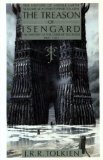 1st U.S. Edition (1989, Houghton Mifflin Company, hc, 0395515629, 504 p)
1st U.S. Edition (1989, Houghton Mifflin Company, hc, 0395515629, 504 p)
- The front cover is again by Alan Lee. This is the first book with a barcode on the book to go along with the ISBN. Again, as with the previous book, the next volume is listed on the back cover as “In Preparation” while inside it is simply listed as Part Three of HOLOTR. To go along with the Alan Lee picture of Orthanc on the front cover there is a Tolkien illustration of Orthanc as a frontispiece.
- The War of the Ring: The History of the Lord of the Rings, Part Three (Volume VIII)
- The third volume of The History of the Lord of the Rings covers almost all the way until the end of Book V. It also deals with the beginnings of Book V, which Tolkien started, then abandoned, not knowing what to do next (as explained in the Forward to the published LOTR). The title chosen for this volume is the one that Tolkien originally wanted for the third part of Lord of the Rings, feeling that Return of the King gave away too much of the story.
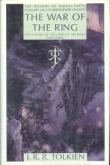 1st U.S. Edition (1990, Houghton Mifflin Company, hc, 039556008x, 476 p)
1st U.S. Edition (1990, Houghton Mifflin Company, hc, 039556008x, 476 p)
- We have another Alan Lee cover, this time depicting the Battle of Helm’s Deep. As with the previous books, this one only lists the next volume as “In Preparation” on the back cover. However, this time it doesn’t even give it a title inside, not even that it is part of HOLOTR. Perhaps because Christopher Tolkien would focus only part of the next book on LOTR, he hadn’t yet decided what to call it or whether he would consider it part of HOLOTR.
- Sauron Defeated: The End of the Third Age (The History of the Lord of the Rings, Part Four) / The Notion Club Papers and The Drowning of Anadûnê (Volume IX)
- The final part of The History of the Lord of the Rings doesn’t take up much of this book – only up to page 141 – and would be published in paperback as The End of the Third Age separately. The rest of the book includes several papers written by Tolkien that have the least amount of bearing on Middle-earth of anything in the series.
 1st U.S. Edition (1992, Houghton Mifflin Company, hc, 0395606497, 482 p)
1st U.S. Edition (1992, Houghton Mifflin Company, hc, 0395606497, 482 p)
- The cover is again by Alan Lee, this time depicting Kirith Ungol. While the back cover does list a Volume X in preparation, for the first time there is absolutely no mention of it in the volumes listed opposite the title page.
- Morgoth’s Ring: The Later Silmarillion, Part One: The Legends of Aman (Volume X)
- This is the first of a two-part set that deal with the later writings that Christopher Tolkien would actually edit and publish as The Silmarillion.
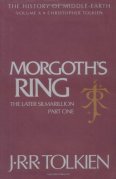 1st U.S. Edition (1993, Houghton Mifflin Company, hc, 0395680921, 471 p)
1st U.S. Edition (1993, Houghton Mifflin Company, hc, 0395680921, 471 p)
- For the later books, HM returned to their style from the first five books. It is all one solid color (in this case, kind of a purplish-maroon), has the title in large bold (in this case the Tolkien symbol is lowered to just below the title instead of just above. It continues to keep the smaller symbol and author name on the spine. The back of the book continues to list “In Preparation” rather than a name for the next volume, although there is no mention inside the book of a next volume. I keep my copy of the last three volumes of the set in a LOTR box (0618153977), because I used to be able to get free LOTR boxes and I don’t have the set that go in this box (hardcover movie cover editions).
- The War of the Jewels: The Later Silmarillion, Part Two: The Legends of Beleriand (Volume XI)
- This is the second part of the later writings, some of the last of Tolkien’s life, that would end up being published as The Silmarillion after his death.
 1st U.S. Edition (1994, Houghton Mifflin Company, hc, 0395710413, 470 p)
1st U.S. Edition (1994, Houghton Mifflin Company, hc, 0395710413, 470 p)
- This book again uses the standard set by the first five books in the series. This time the color is a sea green and the Tolkien symbol on the front is actually even with the title. Again, the next title is listed on the book as “In Preparation” while it is not listed at all inside the book.
- The Peoples of Middle-earth (Volume XII)
- This is the first book in the series since The Lays of Beleriand not to have a sub-title. Perhaps the randomness within this book is the reason, as it covers the writings of the LOTR appendices, as well as later writings that Tolkien did up until his death, include creating chronology among all his tales. It also includes “The New Shadow” the story that actually was the sequel to LOTR that many thought The Return of the Shadow would be.
 1st U.S. Edition (1996, Houghton Mifflin Company, hc, 0395827604, 482 p)
1st U.S. Edition (1996, Houghton Mifflin Company, hc, 0395827604, 482 p)
- While this uses the same style as the previous two books, for some reason, they decided to make it essentially the same color as the previous volume, a kind of sea green. They also move the Tolkien symbol up above the title, as they had with the first five volumes. These last three books all also use the same blurb on the back from Publishers Weekly. Because I have first editions of all the HOME books, this is the only one of them that lists the entire series on the back cover (and inside, opposite the title page). To give an idea of how much changed between the publication of the first book and the last book, Volume I in hardcover was priced at $14.95, while the last two had cover prices of $30.
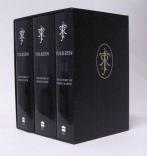 The Complete History of Middle Earth 3 Volume Box Set (2002, HarperCollins Publishers, sh/sc, 0007105088 (set))
The Complete History of Middle Earth 3 Volume Box Set (2002, HarperCollins Publishers, sh/sc, 0007105088 (set))
- This is a gorgeous 3 volume U.K. set. It presents the entire 12 volume series broken up into three books. The books have beautiful black spines with the Tolkien symbol prominent in white. On the front cover is a solid color, with the Tolkien symbol embossed behind the titles in a darker variant, while it also appears in that color on the back cover. These are definitely books for sitting on your shelf – the first two volumes run around 1900 pages each (they keep the pagination from the original hardcover editions).
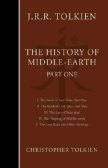 Volume I consists of Volumes I through V (0007149158). The color for this book is burgundy.
Volume I consists of Volumes I through V (0007149158). The color for this book is burgundy. Volume II is The History of the Lord of the Rings (VI-IX) (0007149166). The color for this book is green.
Volume II is The History of the Lord of the Rings (VI-IX) (0007149166). The color for this book is green.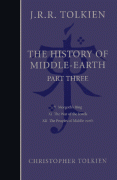 Volume III covers the last three books (X-XII) (0007149174). The color for this book is purple.
Volume III covers the last three books (X-XII) (0007149174). The color for this book is purple.
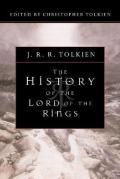 The History of the Lord of the Rings (2000, Houghton Mifflin Company, ss/sc, 0618083553)
The History of the Lord of the Rings (2000, Houghton Mifflin Company, ss/sc, 0618083553)
- This is a a four volume separate set within the History of Middle-earth set, focusing exclusively on the writing of LOTR published together as a set four years after the completion of HOME. This was the first time that any of these books had ever been released in paperback. They were released in a slipcase with Alan Lee illustrations on the slipcase and on the cover of each book. Perhaps because they are trade editions rather than mass markets, these copies, unlike the Ballantine editions of the first 5 volumes keep the same pagination as the original hardcover editions. Descriptions can be found above under each individual entry of HOME. They consist of:
 The Return of the Shadow: The History of the Lord of the Rings, Part One (2000, Houghton Mifflin Company, tp, 061808357x, 497 p)
The Return of the Shadow: The History of the Lord of the Rings, Part One (2000, Houghton Mifflin Company, tp, 061808357x, 497 p) The Treason of Isengard: The History of the Lord of the Rings, Part Two (2000, Houghton Mifflin Company, tp, 0618083588, 504 p)
The Treason of Isengard: The History of the Lord of the Rings, Part Two (2000, Houghton Mifflin Company, tp, 0618083588, 504 p) The War of the Ring: The History of the Lord of the Rings, Part Three (2000, Houghton Mifflin Company, tp, 0618083596, 476 p)
The War of the Ring: The History of the Lord of the Rings, Part Three (2000, Houghton Mifflin Company, tp, 0618083596, 476 p) The End of the Third Age: The History of the Lord of the Rings, Part Four (2000, Houghton Mifflin Company, tp, 0618083561, 159 p)
The End of the Third Age: The History of the Lord of the Rings, Part Four (2000, Houghton Mifflin Company, tp, 0618083561, 159 p)
- This is the one book that gets its own description because it differs from its attendant volume in HOME. The original book, Sauron Defeated, which was Volume IX of HOME not only dealt with the conclusion of LOTR, but also with other Middle-earth writings that Tolkien was doing at that same time. So, when this set was released, Christopher Tolkien only used the parts dealing directly with LOTR, gave it a new title (and added some appendices from Vol XII).
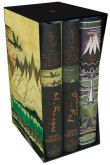 The History of the Hobbit three volume set (John D. Rateliff, 2007, Houghton Mifflin Company, sh, 0618964401, 905 p)
The History of the Hobbit three volume set (John D. Rateliff, 2007, Houghton Mifflin Company, sh, 0618964401, 905 p)
- included in the set are a copy of The Hobbit (listed above) and the two volume History of the Hobbit. These are not strictly part of the History of Middle-earth series, and were not written by Christopher Tolkien. However, as they are of the same kind of book, I have decided to include them here. Both covers and the cover of the box set (which has each cover on one side) uses original water colors from Tolkien. These two books are absolute musts for serious Tolkien fans and are incredibly fascinating. While I often re-read the Annotated Hobbit before re-reading LOTR, this year I actually re-read this set and really dived into the history of its composition.
 The History of the Hobbit Part One: Mr. Baggins (John D. Rateliff, 2007, Houghton Mifflin Company, hc, 0618968474, 467 p)
The History of the Hobbit Part One: Mr. Baggins (John D. Rateliff, 2007, Houghton Mifflin Company, hc, 0618968474, 467 p)
- This book is very much like The Return of the Shadow. It follows the drafting of The Hobbit, going back through the pages that Tolkien wrote and figuring out what was written when. It also allows you to read The Hobbit in very different forms, including with very different names (Gandalf was originally the main dwarf while the wizard’s name was Bladorthin). This book follows the story all the way up to Lake Town, while restarting from the beginning a number of times (Tolkien would write LOTR in the same manner).
 The History of the Hobbit Part Two: Return to Bag End (John D. Rateliff, 2007, Houghton Mifflin Company, hc, 0618969195, 905 p (continues numbering from Part One)
The History of the Hobbit Part Two: Return to Bag End (John D. Rateliff, 2007, Houghton Mifflin Company, hc, 0618969195, 905 p (continues numbering from Part One)
- This book picks up where the previous one left off, dealing with the death of Smaug and The Battle of Five Armies. It also deals with the inconsistencies that would pop up later with the writing of LOTR and how Tolkien would attempt to reconcile them and all the changes that he would make in later editions of the book.
Other Books by Tolkien:
- The Tolkien Reader
- First published in 1966, this was a small volume that collected other writings by Tolkien other than H/LOTR. In fact, it specifically mentioned that it was not going to be an anthology of favorite passages from those books. Instead, it contains, in whole, several books that you may notice I don’t own other copies of, namely Tree and Leaf, Farmer Giles of Ham and The Adventures of Tom Bombadil. There are illustrations throughout by Pauline Baynes, who also illustrated the Narnia books, so you may notice a similarity.
 1975 edition (Ballantine, mm, 0345248317)
1975 edition (Ballantine, mm, 0345248317)
- This edition goes with the 4 Volume Set above (the Ballantine 2nd Issue). It contains Pauline Baynes artwork on the cover, but otherwise is similar in style to the Ballantine second issue set. It has the white spine and cover with the title over Tolkien’s name, followed below by the artwork. Unlike the others, though, it does not have Tolkien’s picture on the book, but rather more artwork from Baynes.
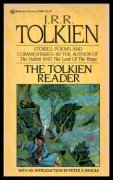 1982 edition (Ballantine, mm, 0345298810, 251 p)
1982 edition (Ballantine, mm, 0345298810, 251 p)
- This edition, like the other edition I have, is published to go along with the Lord of the Rings and Hobbit sets from the time (the Ballantine 3rd Issue). The front cover has the same design – the name across the top, followed by the title, followed by an illustration in a box (while the other books use images from the 1982 calendar, this one continues to use the Pauline Baynes illustration from the previous edition. There is one color across the front, spine and back (in this case a similar shade of gold to what was on The Hobbit), with the description in a scroll on the back. This is the 17th printing of the book, from 1982.
 The Letters of J.R.R. Tolkien (2000, Houghton Mifflin Company, 1st paperback Edition, tp, 0618056998, 502 p)
The Letters of J.R.R. Tolkien (2000, Houghton Mifflin Company, 1st paperback Edition, tp, 0618056998, 502 p)
- I am not a fan of literary biography, as people strive to piece together a person’s life and draw meaning from it and from their writings and insist they interact in meaningful ways. However, letters can be extremely useful, because they can illuminate the actual writing process as its happening and certainly allow a writer to talk about his writing after it has been published and been mis-interpreted. There is ample information in this book that is of interest to a serious LOTR fan. The original edition was published in 1981, then a newer edition with an expanded index was published in 1995, from which this edition is derived.
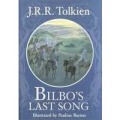 Bilbo’s Last Song (2002, Alfred A Knopf, 1st Edition, hc, 0375823735)
Bilbo’s Last Song (2002, Alfred A Knopf, 1st Edition, hc, 0375823735)
- This is a small little illustrated edition of a poem that Tolkien wrote and gave to his secretary in 1966. This edition of it, illustrated by Pauline Baynes (whose illustrations I don’t like at all) was published in 2002; it was not used in the Jackson films because it wasn’t part of the license, but this edition was clearly published at a time to capitalize on interest in the films.
 The Children of Húrin (2007, Houghton Mifflin Company, 1st Edition, hc, 0618894640 / 9780618894642, 313 p)
The Children of Húrin (2007, Houghton Mifflin Company, 1st Edition, hc, 0618894640 / 9780618894642, 313 p)
- Given that we were right across the street from Houghton Mifflin, there wasn’t actually much interaction between the Borders store that I helped open in November of 2006 and such a major publisher. But one of them was this – we get several free copies of the 1st Edition of The Children of Húrin when it was finally published in the fall of 2007. It had been talked about for a long time, one of the great stories of the First Age of Middle-earth, and here it finally was, complete with full page illustrations from Alan Lee.
Middle-earth Related Books (not written by Tolkien):
These are various other books that don’t fall into the above category but that I keep with the Tolkien books. They are not by him, but are usually reference books that have to do with his world and his writings.
- Bored of the Rings (Harvard Lampoon)
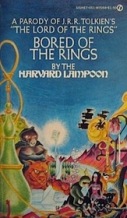 1969 edition (Signet, mm, 0451126548, 160 p)
1969 edition (Signet, mm, 0451126548, 160 p)
- I had long owned the reprint trade copy (see below) of this book before I finally saw the original edition. While the reprint perfectly suits the book itself, this cover is just simply brilliant. It works so well with the original Ballantine editions that I thought it actually was printed by Ballantine, but it is actually printed by Signet (two months ago, those two finally became part of the same parent company, as Ballantine was bought by Random House in 1973 and Signet by Penguin in 1987 and they began their merger in October). The cover is full of ridiculous 60’s psychedelia, the kind of stuff that Tolkien fans were often into and has to be seen to be fully believed (I think my favorite part of it is the malevolent looking anthropomorphic hippo). The brilliant cover is by Michael K. Frith (who was also Dr. Seuss’ editor and a major designer for the Muppets). My copy seems to be a 25th printing of the original Signet edition.
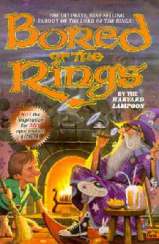 1993 edition (Roc, tp, 0451452615, 149 p)
1993 edition (Roc, tp, 0451452615, 149 p)
- This was the first edition of this book that I owned, purchasing it new not long after it was published. The cover, with a stogie smoking Goodgulf wearing converse is an appropriate cover for the book but it lacks the sheer originality of the original cover. The text inside is the same except for the absence of the endorsements. It also still has the fake sample from the book with the sexualized between Frito and the elf-maiden, but it also has an actual text excerpt before that, where it such a thing normally is placed. In short, it is not quite as wild, but it is still just as funny (my favorite moment always having been Bromosel’s dream in which he hears “Five-eleven’s your height, one-ninety your weight / You cash in your chips around page eighty-eight,” followed only a few lines later, when, frustrated at the revelation of Arrowroot, he “looked up at the top of the page and winced. ‘At least another chapter go,’ he groaned.”
 Tolkien’s World (Randel Helms, 1974, Houghton Mifflin Company, tp, 0395184908, 167 p)
Tolkien’s World (Randel Helms, 1974, Houghton Mifflin Company, tp, 0395184908, 167 p)
- An early attempt at literary criticism, trying to trace its place in fantasy. Not a particularly good book, either in terms of literary merit or in readability, but far from the worst. The cover is one of the more pathetic ones for a book on Tolkien, especially given that it was published by HM.
 Tolkien: A Look Behind The Lord of the Rings (Lin Carter, 1975, Ballantine, mm, 0345245202, 211 p)
Tolkien: A Look Behind The Lord of the Rings (Lin Carter, 1975, Ballantine, mm, 0345245202, 211 p)
- First printed in 1969, this is kind of an introduction guide. Or it isn’t. It’s one of those things that isn’t quite sure what it is. It takes some 35 pages to give the story of LOTR, in three chapters. Yet, it also has a pseudo-literary criticism and history of fantasy and LOTR’s place in fantasy. So, is it for someone who’s already them? And if so, why bother to include such a long summarization of the story? Yet, Ballantine, the official paperback publisher of LOTR decided to publish this. The cover art is by Curtis Woodbridge and seems to have nothing to do with Tolkien at all.
 The Tolkien Quiz Book (Bart Andrews, 1979, Signet, mm, 0451085256, 154 p)
The Tolkien Quiz Book (Bart Andrews, 1979, Signet, mm, 0451085256, 154 p)
- Of all the books in this entire post, this may have the worst cover. It doesn’t have a cover credit, though the name Kirk is quite clear to read in the drawing. It’s a somewhat worthwhile book – if you have a bunch of Tolkien fans around you could use this to find the biggest one (or the one capable of holding the most trivia in their head).
 The Complete Guide to Middle-earth: From The Hobbit to The Silmarillion (Robert Foster, 1985, Ballantine/Del Rey, mm, 0345324366, 575 p)
The Complete Guide to Middle-earth: From The Hobbit to The Silmarillion (Robert Foster, 1985, Ballantine/Del Rey, mm, 0345324366, 575 p)
- One of the absolute seminal reference books to have on Middle-earth. I looked at this book a lot as a kid (both my brothers had copies) before I found my own copy at Raven Used Book Shop in Northampton (my parents were taking my sister to college and I found this shop and bought this book – it was August of 1989). It was first published in 1971, Ballantine published it for the first time in 1974, it was revised in 1978 and Ballantine published the paperback of that edition in 1979. My own copy is the 5th printing from 1985. This is a fantastic encyclopedia that covers every major and minor character in all the books (my brother used it in our discussion on Celeborn here). The cover art by The Brothers Hildebrant, however, leaves much to be desired. Gandalf is fine, and the hobbits are okay. But Legolas I don’t love, Aragorn looks like he’s a musketeer and Gimli is just simply awful.
- The Atlas of Middle-earth (Revised Edition) (Karen Wynn Fonstad)
 1992 edition (1st paperback edition, Houghton Mifflin Company, tp, 0395535166, 210 p)
1992 edition (1st paperback edition, Houghton Mifflin Company, tp, 0395535166, 210 p)
- If I had to venture a guess, I would say that this is the most loved and most owned reference book about Tolkien’s world. The original edition was published in hardcover in 1981 and this new edition followed in 1992. One of the best things about it is how close the maps come to the versions that Tolkien or his son made for the original books. The cover of this edition is one Fonstad’s maps, the one that covers Frodo and Sam’s journey from Rauros to Mordor. A truly wonderful book.
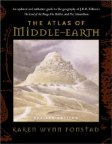 2001 edition (Houghton Mifflin Company, tp, 0618126996, 210 p)
2001 edition (Houghton Mifflin Company, tp, 0618126996, 210 p)
- This is simply a later printing of Fonstad’s book. The only difference between the two copies is that instead of using Fonstad’s map as the cover of the book it uses the Alan Lee illustration of Edoras. While it makes for a very nice looking cover, there was something charming about having one of the maps right there on the cover as a tribute to the great work that Fonstad did.
 The Lord of the Rings Tarot Deck and Card Game (Terry Donaldson, 1997, U.S. Games Systems, Inc., ss, 1572810556)
The Lord of the Rings Tarot Deck and Card Game (Terry Donaldson, 1997, U.S. Games Systems, Inc., ss, 1572810556)
- I am not, as many know, a religious person. Nor am I a mystical person. I find Tarot and such things to be as ridiculous as organized religions, so don’t get any ideas here. My memory of this is that I got this for free or something like that. I keep it because of the amusement and because of my passion for collecting. In fact, when I went to look at it, I discovered it was still shrink-wrapped, even though I have owned it for probably close to (or over) a decade now. This box consists of three things: the actual book The Lord of the Rings Tarot (1572810548, 267 p), the game board (which is really a fold out page) and the Tarot deck itself (1572810173). It’s not even all that Tolkien oriented. Most of the Tarot cards are clearly generic Tarot cards in which Donaldson has tried to tie to the world of Tolkien. Only a few of the cards were obviously designed for this set. And the artwork is pretty bad on all of them.
 A Tolkien Bestiary (David Day, 2001, Gramercy Books, 0517120771, 287 p)
A Tolkien Bestiary (David Day, 2001, Gramercy Books, 0517120771, 287 p)
- As a reference book, this is very good. It contains references to nearly every kind of creature that Tolkien created with good descriptions of them. It describes itself as “sumptuously illustrated” and while there are a lot of illustrations, I would hardly call them sumptuous. Most of them I wouldn’t even call particularly good. The jacket cover is by Ian Miller. This book was originally published in 1979 by Octopus Publishing Group.
 A Tolkien Treasury: The Miniature Edition (2001, Running Press, hc, 0762409800, 93 p)
A Tolkien Treasury: The Miniature Edition (2001, Running Press, hc, 0762409800, 93 p)
- A miniature book of various quotes about Middle-earth, with illustrations running all through the books from a variety of illustrators. It bills itself as “the perfect gift for every Tolkien fan” but it is far from it. Most of the quotes are fairly meaningless, the illustrations aren’t particularly worthwhile and while there are three recipes, the very useful one for lembas is not among them. The cover would seem to be by Tim Kirk, as he is credited with the color illustrations, but there is no specific cover credit.
 The QPB Companion to The Lord of the Rings (2001, Quality Paperback Book Club, tp, 0965307883, 104 p)
The QPB Companion to The Lord of the Rings (2001, Quality Paperback Book Club, tp, 0965307883, 104 p)
- This is a small little guide to views on Tolkien’s work. It includes a variety of reviews (good and bad) and some other articles written over the space between 1937 and 2001 about Middle-earth and all the works relating to it. It then includes some discussion questions, some games and a variety of recipes (but still no lembas damn it). The cover is by Grey Thornberry.
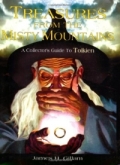 Treasures from the Misty Mountains: A Collector’s Guide to J.R.R. Tolkien (James Gillam, 2001, Collector’s Guide Publishing, tp, 1896522769, 208 p)
Treasures from the Misty Mountains: A Collector’s Guide to J.R.R. Tolkien (James Gillam, 2001, Collector’s Guide Publishing, tp, 1896522769, 208 p)
- I am a bit conflicted about this book. On the one hand, there is no book on this list more in need of a new edition (which will be even more necessary come the summer of 2014 after the last Hobbit film has been released). So much stuff has flooded the market since this guide was printed, just as the wave from the Jackson films was beginning. On the other hand, while this book is filled with a lot of useful information and is a nice guide to early Tolkien collectibles that are extremely hard to find now (but at least thanks to this we know what we’re looking for), it is very badly designed and is not all that good. What we need is something like this, but not this book specifically. But at least we have this, which is a start. And this isn’t easy to find – the only copy I have ever actually seen is my own, possibly because it’s a Canadian publication. There is nothing in the book to indicate who did the artwork.
 The Magical Worlds of The Lord of the Rings: The Amazing Myths, Legends and Facts Behind the Masterpiece (David Colbert, 2002, Berkley Books, tp, 0425187713, 197 p)
The Magical Worlds of The Lord of the Rings: The Amazing Myths, Legends and Facts Behind the Masterpiece (David Colbert, 2002, Berkley Books, tp, 0425187713, 197 p)
- After having written The Magical Worlds of Harry Potter, which was a not particularly good attempt at looking closer at Harry Potter, clearly designed to capitalize on its massive popularity, as it was written when there were still only four books and still too much to figure out (we have it because we were given it as a gift), Colbert tried out his hand with a series that also was massively popular (hey – a film series, good for sales that) and which at least had been long concluded so he wouldn’t have to do nearly as much random speculation. But the result is about as useful (none). I have it, well, I don’t know how I got it, but since I didn’t actually read his Harry Potter book until a couple of years ago, I might not have known how bad this would be. It’s at least better than anything in the “And Philosophy” series. The cover art by Jean Pierre Targete is not very good.
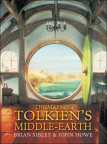 The Maps of Tolkien’s Middle-Earth (Brian Sibley and John Howe, 2003, Houghton Mifflin Company, sh, 061839110x, 80 p)
The Maps of Tolkien’s Middle-Earth (Brian Sibley and John Howe, 2003, Houghton Mifflin Company, sh, 061839110x, 80 p)
- This is a wonderful set. Unlike the Fonstad book, which is an atlas, this is two different things in a slipcase. The first is an 80 page book from Brian Sibley that discusses maps and their use in the books, then includes an encyclopedia of all the major places in Middle-earth. The other book contains four fold-out maps that are gorgeously rendered by artist John Howe: Wilderland, Middle-earth, Beleriand and Númenor. The front cover is the wonderful John Howe depiction of Bag End.
 The Origins of Tolkien’s Middle-earth for Dummies (Greg Harvey, 2003, Wiley, tp, 0764541862, 338 p)
The Origins of Tolkien’s Middle-earth for Dummies (Greg Harvey, 2003, Wiley, tp, 0764541862, 338 p)
- I’ll admit straight out that the only reason I own this book is because the spine is badly damaged and it was going to be tossed and so I got it for free. I really hate the Dummies series of books, and this one in particular really seems like a bad version of a Cliffs Notes. But since I own a large Tolkien collection, I couldn’t bring myself to pass up a free book on LOTR, even if it wasn’t useful or good.
 Tales Before Tolkien: The Roots of Modern Fantasy (ed. Douglas A. Anderson, 2005, Ballantine/Del Rey, mm, 0345458567, 517 p)
Tales Before Tolkien: The Roots of Modern Fantasy (ed. Douglas A. Anderson, 2005, Ballantine/Del Rey, mm, 0345458567, 517 p)
- This book is not technically Middle-earth related. It is a collection of various fantasy stories, all of which predate the publication of The Hobbit. Some of them are stories which were known to be read by Tolkien, while some of the others are ones which seem to have influenced him, though it is not known of he had specific knowledge of them. They are edited by Douglas A. Anderson, the man who also was the editor of The Annotated Hobbit. The cover illustration is a drawing of Minas Tirith by John Howe. Some of the stories aren’t very good but some of them are very enjoyable and the book is a great addition to any fantasy collection, if, for no other reason, than to show the state of fantasy before the massive influence of Tolkien began to take it over.
Middle-earth Art:
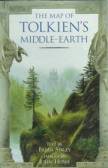 The Map of Tolkien’s Middle-earth (text by Brian Sibley, images by John Howe, 1994, HarperCollins Publishers, 0261103180)
The Map of Tolkien’s Middle-earth (text by Brian Sibley, images by John Howe, 1994, HarperCollins Publishers, 0261103180)
- This is a beautifully rendered map of Middle-earth that folds out from a cardboard sleeve, a companion to the Hobbit map. There is a small little booklet on the other half of the sleeve, with a brief overview and then a glossary of the major places on the map. Sibley and Howe would collaborate again on an expanded version of this that is listed above (because it has much more text, though the art is still key).
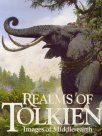 Realms of Tolkien: Images of Middle-earth (1996, HarperPrism, hc, 0061055328)
Realms of Tolkien: Images of Middle-earth (1996, HarperPrism, hc, 0061055328)
- A very nice collection that covers a good array of those who have become known for their Middle-earth art, including Alan Lee, John Howe and Ted Nasmith. The cover is by Ted Nasmith. As with any art collection, there are good points and bad points – my favorite one in the bunch is Ungoliantë and Melkor by John Howe. Unfortunately, there are several pieces from Cor Blok, whose work I don’t like at all (and, annoyingly, was the 2011 and 12 artist for the Tolkien Calendar).
 J.R.R. Tolkien: Artist & Illustrator (Wayne G. Hammond and Christian Scull, 2000, Houghton Mifflin Company, tp, 0618083618, 207 p)
J.R.R. Tolkien: Artist & Illustrator (Wayne G. Hammond and Christian Scull, 2000, Houghton Mifflin Company, tp, 0618083618, 207 p)
- This paperback of a 1995 book is a collection of 200 prints of art that J.R.R. Tolkien did in his lifetime. Not all of it is strictly Middle-earth related, though that is obviously the bulk of it. Because so many people have made names for themselves with the artwork they have done concerning Middle-earth, it often seems to be overlooked that Tolkien did a lot of original artwork for his writings, especially for The Hobbit. This is a great introduction to it, as it has a full description to go along with every print.
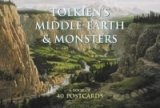 Tolkien’s Middle-earth & Monsters (2002, HarperCollins Publishers, hc, 0007142595, 40 p)
Tolkien’s Middle-earth & Monsters (2002, HarperCollins Publishers, hc, 0007142595, 40 p)
- This is a book of 40 postcards that was originally published as two separate books (Tolkien’s Middle-earth and Tolkien’s Dragons & Monsters) in 1993. They were put together in 2002 to capitalize on the films. They include a wide variety of artists, including Alan Lee, John Howe and Ted Nasmith (whose drawing of Rivendell is on the cover). Like with almost any postcard book like this, I have never mailed (or even taken out) any of the postcards.
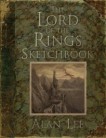 The Lord of the Rings Sketchbook (2005, Houghton Mifflin Company, hc, 0618640142, 191 p)
The Lord of the Rings Sketchbook (2005, Houghton Mifflin Company, hc, 0618640142, 191 p)
- A whole book of original pencil sketches from Alan Lee, one of the foremost illustrators of Middle-earth and a conceptual designer for the films. These show how he developed some of his most well-known illustrations from the illustrated editions, as well as some of the conceptual art for the films. If there is a beef to be had with this book it is that it does not include any of the sketches that appeared in the end credits of ROTK.
 Myth & Magic: The Art of John Howe (2007, HarperCollins Publishers, hc, 9780007107957, 141 p)
Myth & Magic: The Art of John Howe (2007, HarperCollins Publishers, hc, 9780007107957, 141 p)
- This is not strictly a book of Middle-earth art. However, Howe has become mostly known for the artwork he has done and he served as a conceptual designer for the films. A lot of the pieces showcased in this book have been the cover art for editions of Tolkien’s book or other books having to do with Middle-earth. This is actually a 2001 book, but my copy (4th printing) must date from at least 2007, because it has a 13 digit ISBN. And clearly they wanted to make to connection to the films as the introduction is by Peter Jackson and there is a page of text by Ian McKellen about getting the visual image of Gandalf from Howe’s art.
 The Art of the Hobbit by J.R.R. Tolkien (Wayne G. Hammond & Christina Scull, 2012, Houghton Mifflin Company, hc, 9780547928258, 144 p)
The Art of the Hobbit by J.R.R. Tolkien (Wayne G. Hammond & Christina Scull, 2012, Houghton Mifflin Company, hc, 9780547928258, 144 p)
- A nice brand new book designed to coincide with the films (and the 75th anniversary of The Hobbit), this coffee table book contains all of the original art that Tolkien ever did for The Hobbit. The front cover takes the entire dust jacket for the 1st Edition and prints it all as one scene on the front (instead of back, spine, front, like on the original).
Books About Tolkien:
My classification here is that these books are specifically about J.R.R. Tolkien himself rather than about Middle-earth. As a group, these might be the weakest link in this post because so many of them want to find meaning in his life to explain his work.
 J.R.R. Tolkien: Architect of Middle Earth (Daniel Grotta-Kurska, 1977, Warner Books, mm, 0446894109, 245 p)
J.R.R. Tolkien: Architect of Middle Earth (Daniel Grotta-Kurska, 1977, Warner Books, mm, 0446894109, 245 p)
- First published by Running Press in 1976, this is the 1st printing of the paperback. A very standard, not all that useful literary biography. It has a few instances of “Material deleted for legal considerations,” and I don’t know what that is about. The cover is a Brothers Hildebrant picture, one of the few which I don’t mind – a very charming picture and perfect for such a book (and much much better than the one for the 1st Edition which I don’t have, where various dwarves are climbing out of Tolkien’s head). By the way, the error in “Middle Earth” (as opposed to Middle-earth, as is used in Tolkien’s work) is from the book, not mine.
 Understanding Tolkien and The Lord of the Rings (William Ready, 1978, Warner Books, mm, 044688782x, 96 p)
Understanding Tolkien and The Lord of the Rings (William Ready, 1978, Warner Books, mm, 044688782x, 96 p)
- Not a whole lot better than the Grotta-Kurska book. This was originally published as The Tolkien Relation by Henry Regnery Company in 1968, making it the rare book on Tolkien that was actually published while he was still alive. It is a very thin book that tries to find ways to make Tolkien accessible to those who don’t find him to be so, but also be a guide for those who already love him. The cover is really pretty awful and there is no credit given for who designed it.
 Myth Maker: J.R.R. Tolkien (Anne E. Neimark, illustrated by Brad Weinman, 1996, Harcourt Brace & Company, hc, 0152988475, 118 p)
Myth Maker: J.R.R. Tolkien (Anne E. Neimark, illustrated by Brad Weinman, 1996, Harcourt Brace & Company, hc, 0152988475, 118 p)
- This is one of those kids biographies, the kind that your grade school child uses to write his biography report on someone. The illustrations are well-done pencil sketches appropriate for such a work. This is the 1st Edition, but is an ex-library book from BPL (which is in fact where I got – for about a buck at a library book sale).
 J.R.R. Tolkien: Author of the Century (Tom Shippey, 2002, Houghton Mifflin Company, tp, 0618257594, 347 p)
J.R.R. Tolkien: Author of the Century (Tom Shippey, 2002, Houghton Mifflin Company, tp, 0618257594, 347 p)
- This is the first paperback printing of the book on Tolkien that was originally published in hardcover in 2000. As I am not a fan of literary biography, I hadn’t bothered to get this book for a long time, but it eventually ended up on the dollar cart at work so I picked it up. This book kind of belongs half in this category and half in the previous one, as Shippey focuses more on the writing than the man, but I still stuck it here because of how it deals with how Tolkien came to create the works rather than the works themselves. It’s pretty good for this kind of book, as should be expected from Shippey who knew Tolkien a little and who has been writing some of the best stuff on him and his work for 30 years.
Film Books:
These are books which are not about the things that Tolkien wrote or his life, but specifically dealing with the films that have been made from the books.
- Visual Companions:
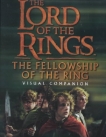 The Lord of the Rings: The Fellowship of the Ring Visual Companion (Jude Fisher, 2001, Houghton Mifflin Company, hc, 0618154019, 65 p)
The Lord of the Rings: The Fellowship of the Ring Visual Companion (Jude Fisher, 2001, Houghton Mifflin Company, hc, 0618154019, 65 p)
- This book, like the ones for the other two films, is a companion for the film, introducing you to the characters and the places, filled with stills from the films. It essentially could have served as a guide to the Academy of Motion Picture Arts and Sciences for reasons to nominate the films for Art Direction (3 noms, 1 win), Costume Design (2 noms, 1 win) and Makeup (2 wins). But, because they don’t want to give away the big visual surprise of the film, the glaring omission in the book is any images which show you the Balrog.
 El Señor de los Anillos: La comunidad Del Anillo Álbum de la Película (Jude Fisher, 2001, Ediciones Minotauro, hc, 8445073613, 65 p)
El Señor de los Anillos: La comunidad Del Anillo Álbum de la Película (Jude Fisher, 2001, Ediciones Minotauro, hc, 8445073613, 65 p)
- Yes, I have the same book of the film in Spanish. It’s called OCD. You can look it up. The only difference is that the text is in Spanish (translated by Estela Gutiérrez Torres).
 The Lord of the Rings: The Two Towers Visual Companion (Jude Fisher, 2002, Houghton Mifflin Company, hc, 0618258027, 63 p)
The Lord of the Rings: The Two Towers Visual Companion (Jude Fisher, 2002, Houghton Mifflin Company, hc, 0618258027, 63 p)
- One of the tricky things with a book like this is that it needs to go to press in time to be released in conjunction with the film. So, sometimes things get edited and appear in the book but aren’t actually in the finished film. The big one in this book became even bigger when the scene also failed to end up in the Extended Edition. That’s because this was the flashback scene that showed Sméagul and the discovery of the ring. That scene, originally slated for inclusion in Towers, was instead pushed forward to be the opening scene of King, even though one of the stills from it is in this book.
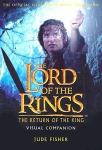 The Lord of the Rings: The Return of the King Visual Companion (Jude Fisher, 2003, Houghton Mifflin Company, hc, 0618390979, 68 p)
The Lord of the Rings: The Return of the King Visual Companion (Jude Fisher, 2003, Houghton Mifflin Company, hc, 0618390979, 68 p)
- As with the previous book, there are scenes here that were not actually in the theatrical release of the film. These include a big two-page spread of the Witch King confronting Gondor in Minas Tirith, as well as the scenes where Sam and Frodo are disguised as orcs, and first are pressed into service, and later, after they have escaped, get rid of their belongings. They also still tried to keep some of the look of the film secret, as there are no pictures of Shelob.
 The Lord of the Rings Complete Visual Companion (Jude Fisher, 2004, Houghton Mifflin Company, tp, 0618510826)
The Lord of the Rings Complete Visual Companion (Jude Fisher, 2004, Houghton Mifflin Company, tp, 0618510826)
- There are a few differences between this book and the previous ones. First, this one covers all three movies. Second, this one was never printed in hardcover. Third, because this one was printed after all the films had been finished and released on DVD, there wasn’t the problem of using stills from scenes that weren’t included. Also, it means they didn’t have to worry about holding things back, so images of the Balrog and Shelob appear, as well as images all the way up to the final moments of the film at the Grey Havens.
- The Art of Lord of the Rings:
 The Lord of the Rings: The Art of The Fellowship of the Ring (Gary Russell, 2002, Houghton Mifflin Company, hc, 0618212906, 192 p)
The Lord of the Rings: The Art of The Fellowship of the Ring (Gary Russell, 2002, Houghton Mifflin Company, hc, 0618212906, 192 p)
- Like the Visual Companions, these books are almost designed to be sent out to show off the Art Direction, Costume Design and Makeup. Though, with all the visual sketches, you also get an idea of the kind of visual effects necessary to achieve what they did on screen. Because these books were released after the films came out, rather than at the same time, they do actually show off all the finished parts of the film, so you can get an idea of what went into the design of say, the Balrog.
 The Lord of the Rings: The Art of The Two Towers (Gary Russell, 2003, Houghton Mifflin Company, hc, 0618331301, 192 p)
The Lord of the Rings: The Art of The Two Towers (Gary Russell, 2003, Houghton Mifflin Company, hc, 0618331301, 192 p)
- Just like the first book, this is a great compendium of artwork that was used to help create the film. It ends with 25 pages on all the conceptual artwork and design that went into the creation of Gollum, so much so that they eventually spun that off into its own separate book.
 The Lord of the Rings: The Art of The Return of the King (Gary Russell, 2004, Houghton Mifflin Company, hc, 0618430296, 192 p)
The Lord of the Rings: The Art of The Return of the King (Gary Russell, 2004, Houghton Mifflin Company, hc, 0618430296, 192 p)
- The third in the series, absolutely filled with gorgeous artwork, although it doesn’t include most of the last part of the film, wanting to keep things back before people actually got a chance to see it.
 The Art of The Lord of the Rings (Gary Russell, 2004, Houghton Mifflin Company, tp, 0618510834, 223 p)
The Art of The Lord of the Rings (Gary Russell, 2004, Houghton Mifflin Company, tp, 0618510834, 223 p)
- Like the Complete Visual Companion, this is a compendium, with a lot of things that were in the other three books, but also some that wasn’t (including the last page, which includes all the head shots that Alan Lee created to go over the end credits). This one focuses much more on the overall look of the films rather than individual characters. Annoyingly, there is no credit for the art on the cover, though it looks a lot like a Ben Wootten drawing in Weapons and Warfare.
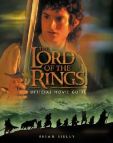 The Lord of the Rings Official Movie Guide (Brian Sibley, 2001, Houghton Mifflin Company, hc, 0618154027, 119 p)
The Lord of the Rings Official Movie Guide (Brian Sibley, 2001, Houghton Mifflin Company, hc, 0618154027, 119 p)
- This is essentially an old-fashioned film program, the kind they used to make all the time (I have one for Doctor Zhivago that my mom got when the film was released). It has a page for each major cast member, talking about their character and the actor’s career. The only odd thing about this book is that I expected them to do the same for the other two films and as far as I know they didn’t, which means that the characters not in the first film (those from Rohan and Gondor) aren’t in this book.
 The Lord of the Rings: The Making of the Movie Trilogy (Brian Sibley, 2002, Houghton Mifflin Company, hc, 0618258000, 191 p)
The Lord of the Rings: The Making of the Movie Trilogy (Brian Sibley, 2002, Houghton Mifflin Company, hc, 0618258000, 191 p)
- This is the most text-heavy of all the books to go along with the films. It does have a good collection of stills as well as pictures from various aspects of making the film, including the music, all the way up to the premiere, with a number of photos from that as well. This is a nice guide to the whole process of making the films, although it was published in between the release dates of Fellowship and Towers.
 The Lord of the Rings: The Two Towers Photo Guide (2002, Houghton Mifflin Company, tp, 0618257365, 46 p)
The Lord of the Rings: The Two Towers Photo Guide (2002, Houghton Mifflin Company, tp, 0618257365, 46 p)
- This is what used to get printed all the time as a storybook for younger kids to go along with a movie – kind of like a picture book novelization. I have several of them for the Star Wars films, though they were bigger and hardbound. I somehow don’t have the one for Fellowship. The one for TTT also includes stickers, which I can’t bring myself to take out. Like the Visual Companions, this has scenes from the film that didn’t end up in the finished film, but hey so did the Star Wars Storybook (it had the Biggs scene from Tatooine).
 The Lord of the Rings: The Two Towers Creatures (2002, Houghton Mifflin Company, tp, 0618258116)
The Lord of the Rings: The Two Towers Creatures (2002, Houghton Mifflin Company, tp, 0618258116)
- Like the Photo Guide, this is mainly meant for younger readers, to introduce them to the creatures in the film with a lot of stills. However, like with the Photo Guide, it was probably mostly bought by people like me. It comes with a pretty fantastic fold out poster of the Balrog confronting Gandalf on the bridge.
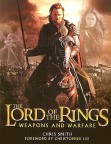 The Lord of the Rings: Weapons and Warfare (Chris Smith, 2003, Houghton Mifflin Company, hc, 0618390995, 218 p)
The Lord of the Rings: Weapons and Warfare (Chris Smith, 2003, Houghton Mifflin Company, hc, 0618390995, 218 p)
- This is a great book for anyone for any fantasy lover, whether it be of films or novels (or both) who is interested in weaponry or armor. It goes in-depth with each character’s weapons and how they would have been used in battle with plenty of pictures.
- The Lord of the Rings: Weapons and Warfare (Chris Smith, 2003, Houghton Mifflin Company, tp, 0618391002, 218 p)
- Wait. You’re thinking, this is the same book as before, except it’s the paperback instead of the hardcover and has the next numeric ISBN. Why the hell do you have both? What the hell is wrong with you? Well, read this cartoon. That’s me in the bottom panel.
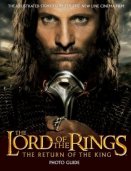 The Lord of the Rings: The Return of the King Photo Guide (2003, Houghton Mifflin Company, tp, 0618390987, 47 p)
The Lord of the Rings: The Return of the King Photo Guide (2003, Houghton Mifflin Company, tp, 0618390987, 47 p)
- For an idea of what this is, look above at the TTT Photo Guide. For some reason I actually have two copies of this book. I have no explanation except that one is an ex-library copy from BPL and I must have bought at a library book sale not remembering that I already had it. What’s annoying is that this one doesn’t have stickers (since I have two, I would have taken stickers out of one and used them).
 The Lord of the Rings: Gollum: How We Made Movie Magic (Andy Serkis, Houghton Mifflin Company, tp, 0618391045, 119 p)
The Lord of the Rings: Gollum: How We Made Movie Magic (Andy Serkis, Houghton Mifflin Company, tp, 0618391045, 119 p)
- While many of the books to go along with the films were clearly designed to help its financial success or immediately feed off it, this was something that only came out because of its artistic success. The process of creating Gollum turned out to be so impressive, both from the technical point-of-view, but also from the acting, that there began to be talk of Andy Serkis competing for the Oscar (which is mentioned in the book). Here, Serkis, with asides from the major creative voices, discusses the process of creating the character, both as an actor, and as an observer to the visual creation.
 The Lord of the Rings: The Return of the King Jigsaw Book (2003, Five Mile Press Pty Ltd, 1741240476)
The Lord of the Rings: The Return of the King Jigsaw Book (2003, Five Mile Press Pty Ltd, 1741240476)
- This was a slam-dunk for me. Even though the 6 puzzles in the book only have 48 pieces each, there was no more certain way to get my attention. I am a huge Tolkien fanatic. But I am also a big lover of jigsaw puzzles – they fit perfectly into the way my brain works. I actually have several LOTR puzzles, but since this one actually comes printed in a book, it ends up listed here.
 The Lord of the Rings Trilogy Jigsaw Book (2004, Five Mile Press Pty Ltd, 1741244323)
The Lord of the Rings Trilogy Jigsaw Book (2004, Five Mile Press Pty Ltd, 1741244323)
- Another slam-dunk. This one only has 4 puzzles, but it is a lot wider and they are 96 piece puzzles. How they decided on Frodo, Aragorn, Gollum and . . . Arwen? is a little beyond me, but it is what it is.
 The Lord of the Rings: The Films, The Books, The Radio Series (Jim Smith and J Clive Matthews, 2004, Virgin Books, tp, 0753508745, 234 p)
The Lord of the Rings: The Films, The Books, The Radio Series (Jim Smith and J Clive Matthews, 2004, Virgin Books, tp, 0753508745, 234 p)
- Though this is listed after all those books that had to do with the Jackson films, this is not just about the Jackson films. In fact, this book gives information about every adaptation of Tolkien’s work – including the early attempts, the Rankin / Bass adaptations and the Bakshi film and give background on the development of the Jackson films. Though I don’t always agree with their assessments, this is just about the only place that does have an assessment at all the attempts to dramatize Tolkien’s works. It’s a British book that I happened to find in a used book shop in Montreal.
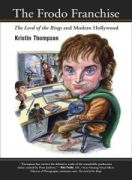 The Frodo Franchise: The Lord of the Rings and Modern Hollywood (Kristin Thompson, 2007, University of California Press, hc, 9780520247741, 399 p)
The Frodo Franchise: The Lord of the Rings and Modern Hollywood (Kristin Thompson, 2007, University of California Press, hc, 9780520247741, 399 p)
- As one would expect from a serious film scholar like Thompson and from a series press like University of California, this is actually a pretty good scholarly study of how the Jackson films ended up coming about, from their initial conception, all the way through to their execution and their enormous success. It talks about how Hollywood has interacted with the works of Tolkien and it is interesting and very well documented. The cover illustration, though of questionable quality, is a smart design and is by Victor Juhasz.
Calendars:
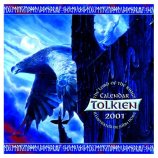 2001 Tolkien Calendar (HarperEntertainment, 0061058521)
2001 Tolkien Calendar (HarperEntertainment, 0061058521)
- Unlike my brothers, I hadn’t asked for Tolkien calendars every year (in fact, prior to 2001, I rarely had a wall calendar). But I hadn’t realized I had nothing before this one. This one is entirely done by John Howe and has some really great illustrations in it. In fact, I can’t mention just one because I love just about every illustration in this calendar – it’s only missing his classic Gandalf illustration.
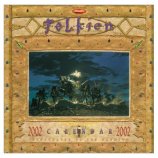 2002 Tolkien Calendar (HarperEntertainment, 0066211549)
2002 Tolkien Calendar (HarperEntertainment, 0066211549)
- The 2002 calendar was illustrated by Ted Nasmith. It is a bit of a mix. I really dislike the “Beyond the Forest” illustration for February (I especially dislike his depiction of Goldberry). But “Gandalf Escapes Upon Gwaihir” is especially good, as is the untitled middle (and cover) illustration which appears to be Gandalf pursued by the Black Riders. Probably due to the release of the first film, every illustration is a scene from Fellowship except the last one, “At the Falls”, which while from Towers, is depicted in the film of Fellowship.
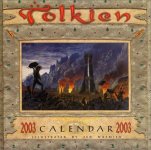 2003 Tolkien Calendar (HarperEntertainment, 0060086564)
2003 Tolkien Calendar (HarperEntertainment, 0060086564)
- For 2003, they again went with Ted Nasmith. This is a better group than the previous one. I think it’s that I don’t really like how Nasmith does figures, but his landscapes and buildings are fantastic. So, in pictures like “The Riders of Rohan” (March), “First Sight of Ithilien” (July) and “The Tower of the Moon”, I love what he does, because the figures are such a small part of it. These are all illustrations from Towers, which makes sense because the film was released at the end of 2002. However, it includes one illustration, “Boromir’s Last Stand” which had been depicted in the first film (which is odd since they put his funeral scene in the previous calendar), and the last three were all pushed back to the final film (with one of them – “At the Cross-Roads” only being in the Extended Edition. We don’t appear to have used this calendar.
 2003-2004 Student Planner (Cedco Publishing Company, 0768363438)
2003-2004 Student Planner (Cedco Publishing Company, 0768363438)
- This is specifically a Two Towers planner, which is odd since ROTK would have been coming out that December. All of the stills, accompanying each page, is from the film and the quality is not particularly good. I thought at first that this had not been used, especially as I never really use desktop planners like this. But it turns out I did, at least for a stretch, beginning in late March. Some of it has to do with when I was a student at PSU, but key dates appear, such as the beginning of our childbirth classes at Kaiser Sunnyside on 28 April. There is also written in on 26 June: “DUE DATE for EOWYN / THOMAS”.
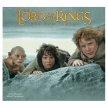 2004 Two Towers 16 Month Calendar (Day Dream Brand, 0768850436)
2004 Two Towers 16 Month Calendar (Day Dream Brand, 0768850436)
- This is a calendar of film stills from The Two Towers. Like with the Student Planner, the stills aren’t the best looking (in terms of quality of print, not of choice of still). I have no memory of this calendar hanging anywhere, which is especially odd, since the one below hung in our kitchen, and I’m not certain why we had two film calendars for the same year (or why they even printed them).
 2004 Return of the King Calendar (Day Dream Brand, 076885248x)
2004 Return of the King Calendar (Day Dream Brand, 076885248x)
- This is specifically a Return of the King calendar, with stills from the film. Like with the Student Planner, the stills are not of the greatest quality. I remember this calendar hung in our kitchen when we owned our house the year Thomas was born but it seems to have been mostly decorative as it was never written on.
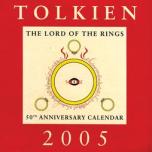 2005 Tolkien Calendar (HarperEntertainment, 0060722983)
2005 Tolkien Calendar (HarperEntertainment, 0060722983)
- After a year with two film calendars, I went back to the official Tolkien Calendar for 2005. For the 50th Anniversary Calendar of Lord of the Rings (based off the British publication of the books), they went back to Tolkien’s original artwork. These have some absolutely wonderful artwork that Tolkien did, which, unlike his illustrations for The Hobbit which have been in many editions, haven’t been seen all that much. We apparently used this in spurts, which makes sense since we actually moved three times during the course of the year.
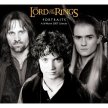 2007 Lord of the Rings Portraits 16 Month Calendar (Day Dream Brand, 0768877865)
2007 Lord of the Rings Portraits 16 Month Calendar (Day Dream Brand, 0768877865)
- This is a 16 month calendar, although what they mean by 16 months is that the last four months of 2006 would be presented all on one page. These are all nice black-and-white photographs of the major people in the film – all 9 of the Fellowship (all though for some reason Pippin is left off the back cover), Bilbo, Arwen, Galadriel and Saruman. We made good solid use of this calendar, with the key date being August 13, where it says “V’s 1st Day new job”, the job that she still has.
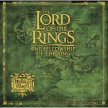 2010 Fellowship of the Ring Special Edition Calendar (Day Dream Brand, 1423801164)
2010 Fellowship of the Ring Special Edition Calendar (Day Dream Brand, 1423801164)
- This one wasn’t actually designed to go on a wall – the special edition part of it is that it folds out into a stand and can stand on your desk. It opens up, then the calendar folds out sideways – almost a combination of wall and desk calendars. It is specifically a Fellowship of the Ring calendar.
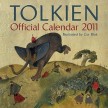 2011 Tolkien Calendar (HarperCollins Publishers, 9780062022172)
2011 Tolkien Calendar (HarperCollins Publishers, 9780062022172)
- After years at Borders where I had no control over calendars, I was at an independent bookstore where I could order in one through our brilliant employee Lisa. So for the first time in six years, I decided to get the official Tolkien Calendar. What I didn’t know was that it would feature artwork from Cor Blok and I hate his illustrations. But, I had asked her to special order it, so I got it and stuck with it all year. And to justify it, for the first time in years, we actually made use of the calendar.
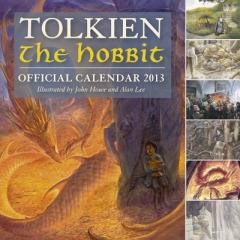
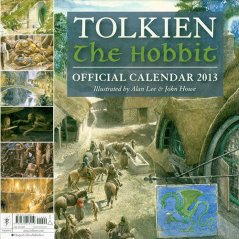 2013 Tolkien Calendar (HarperCollins Publishers, 9780062208019)
2013 Tolkien Calendar (HarperCollins Publishers, 9780062208019)
- Having skipped 2012 (they again went with Cor Blok, but this time I knew it and avoided it), to celebrate the release of The Hobbit, they went with two of the best Tolkien illustrators and two whose conceptual designs have been key to the Jackson films: John Howe and Alan Lee. To do it fairly, they split it evenly – Howe did the odd months and Lee did the even months. They even split the cover – one side is all Howe’s artwork while the other side is all Lee’s (even swapping first credits on either side) with the ISBN and title on both sides. It is a wonderful calendar which I look forward to using, especially March which has what might be my favorite Middle-earth illustration: John Howe’s “A Hobbit Dwelling”.
Journals:
 A Hobbit’s Journal: Being a blank book with some various illustrations of Friends & Foes of the Nine Companions, From the Collection of Sam Gamgee (1979, Running Press, 0762409541)
A Hobbit’s Journal: Being a blank book with some various illustrations of Friends & Foes of the Nine Companions, From the Collection of Sam Gamgee (1979, Running Press, 0762409541)
- This is a fairly flimsy white paperback journal that, as it says, is accompanied with a number of illustrations by Michael Green (which I don’t think are very good).
 The Lord of the Rings: The Fellowship of the Ring: There and Back Again . . . A Journal (2001, Cedco Publishing Company, 0768325218)
The Lord of the Rings: The Fellowship of the Ring: There and Back Again . . . A Journal (2001, Cedco Publishing Company, 0768325218)
- This is a gorgeous little red journal, complete with the initials BB on the cover, clearly designed on the prop used in the Jackson films as Bilbo’s memoirs, later known as The Red Book of Westmarch. It is about 140 pages and comes with a front paper of the map of Middle-earth and a faint copy of the map printed on each page. For a long time, I couldn’t decide what to do with this – it seemed too gorgeous to use in anything but a meaningful way, especially when I think about the story that Bilbo tells in his. Then I had an idea. I would keep a journal. But it’s not for me. It’s for Thomas. I began it on 13 September 2009 and though there have been some big gaps, I continue to write in it. It is my way of communicating with the Thomas that will be (every entry is addressed to him) and letting him know about our lives now and I hope to give it to him when he turns 18.
 The Lord of the Rings Journal (2002, Cedco Publishing Company, 076832579x)
The Lord of the Rings Journal (2002, Cedco Publishing Company, 076832579x)
- This is a very nice red leather journal, about 100 pages, with the ring inscription on the cover. So far it has not been used.
” ‘Well, I’m back,’ he said.”
- the Tolkien symbol:
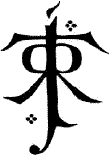
- abbreviations:
- H – The Hobbit
- LOTR – The Lord of the Rings
- FOTR – The Fellowship of the Ring
- TTT – The Two Towers
- ROTK – The Return of the King
- HOME – The History of Middle-earth
- HOLOTR – The History of the Lord of the Rings
- author / editor – the former if not written by Tolkien, the latter if it is posthumous or a collection
- year – the year my specific printing is from, if possible
- publisher – the publisher of the specific book
- George Allen & Unwin – the original U.K. publisher of The Hobbit and LOTR
- HarperCollins Publishers – they became the U.K. publisher upon their purchase of George Allen & Unwin in 1990
- Houghton Mifflin Company – the U.S. publisher of The Hobbit and LOTR, including hardcover and trade editions
- Ballantine – since 1965, the mass market U.S. publisher of The Hobbit and LOTR; since @1999 they have published them in conjunction with Del Rey
- binding:
- hc – hardcover
- tp – trade paperback
- mm – mass market paperback, 4×7
- sh – set hardcover
- ss – set softcover
- sm – set of mass markets
- lt – leatherbound
- fl – flexible
- sc – slipcase
- xh – book club hardcover
- ISBN / Catalog # – ISBNs began in 1965, but weren’t regularly used until after 1970. 13 digit ISBNs began in 2007. I use whatever the book has.
- pages – last numbered page in book (not necessarily the last page); if there are no pages listed that means the pages aren’t numbered

20 December, 2012 at 11:56 pm
Wow that is quite a collection! I have read Tolkien several times myself. I discovered Tolkien just a few years ago. I am sure that I will be reading them dozens of times in my future. There is another author who is releasing a new book that I am dying to read! The author is S. L. Whyte and the book is called, “Stelladaur: Finding Tir Na Nog”. The story is a young adult fantasy novel with romance. The main character, a sixteen year-old boy, discovers he has unusual powers, which takes him on a journey of discovery. I love the video clip on the website! This book is being released in March. I hope I can wait that long! http://www.stelladaur.com/
27 December, 2012 at 8:05 pm
You got your brothers editions of the Hobbit that you yourself don’t like?
Is this your longest post ever?
27 December, 2012 at 8:18 pm
Yes and yes.
30 December, 2012 at 2:26 pm
What’re your thoughts on “Tolkien and the Silmarillion” by Clyde Kilby? It’s a smallish book I picked up a few years ago at a used bookstore. Kilby was apparently Tolkien’s assistant post LOTR pre Silmarillion and was helping him to organize his papers as he worked on the Silmarillion. The book was published, I believe before Christopher Tolkien and the estate had any plans to publish the Silmarillion. It’s quite interesting as it’s mainly about Tolkien’s process.
6 March, 2013 at 2:53 am
Which one would you prefer of the two young readers editions of The Hobbit? 061815082X or 0618260307? Can you give some more information about them, like which one has better paper quality?
14 February, 2014 at 3:13 pm
You have no idea how jealous I am right now! I just started my collection about a month ago and I’m trying to hold myself back enough so that I don’t go broke but there are so many beautiful books out there! I’m glad someone else understands my obsession with owning many editions of the same book.
2 April, 2014 at 6:45 pm
That’s a great collection: I’m very impressed not only by what you’ve been able to acquire, but by how you’re able to discuss what each particular edition means to you. Always a hard concept to explain to non-bibliophiles (“Why do you need two copies of the same book?”).
I will pick a minor nit: Douglas A. Anderson’s “Note on the Text” appeared in the Houghton Mifflin reprint editions of 1987 before he updated it for the 1994 HarperCollins reset edition. I believe that was its first appearance: see http://en.wikipedia.org/wiki/Douglas_A._Anderson for a mention of this.
11 August, 2014 at 2:56 am
Hi nighthawk4486,
Awesome stuff there.
For my own geek activity I am starting on a handwritten leather bound journal style diary of a faithful Hindi translation of ‘The Hobbit’ complete with drawings and all. Something, as done by Indy Magnoli (please follow the link below to see) but in Hindi.
http://www.indyprops.com/pp-rb.htm
If interested in their own copy then please contact me through my email deepak.agrawal.msoe@gmail.com
12 August, 2014 at 10:26 pm
I stumbled upon this post while looking for differences in the size of “The Book of Lost Tales” in hardcover. I notice in the picture you have a copy that is the same size as the rest of the Histories, then you have the copy I have which is slightly smaller and has blue lettering instead of gold (not the dust jacket, but the cover itself). I don’t know if my finding this post now comes 2 years too late, but I would to know the difference between the two, and where I can get the copy that matches the size of the rest.
13 August, 2014 at 6:55 pm
I’m surprised I didn’t mention it in the text of the post, but it seems like I didn’t.
That copy (and yours, as well, I assume) is a book club edition. That’s why it’s smaller and is printed slightly differently. If you have a dust jacket, don’t be surprised if it’s missing a price.
4 January, 2015 at 12:42 am
Beautiful collection, I have a major collection myself. My most rare pieces are 4 ltor calandars from 1972 to 1976 two illustrated by the brothers Hildebrand and two are Tolkien illustrations. My hobbit 1977 lp is the 12 page version. I also have two alan lee art books for the hobbit and ltor. And many more to show. So I may make a page like this too. Awesome collection man.